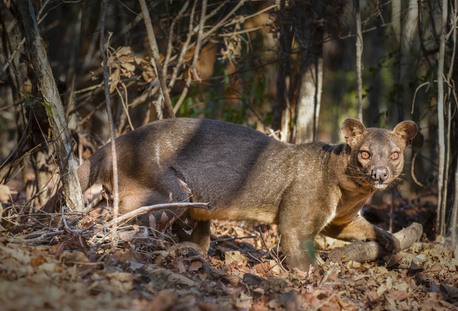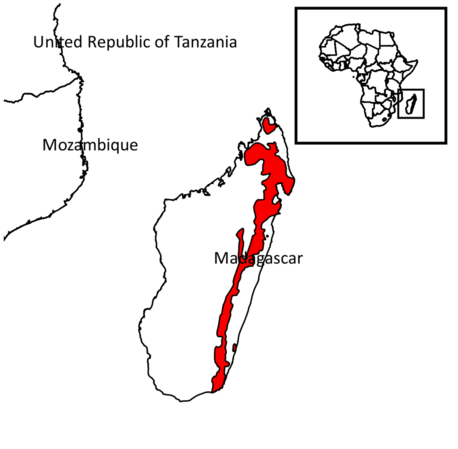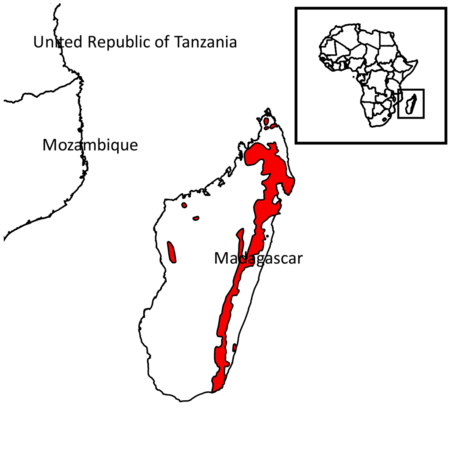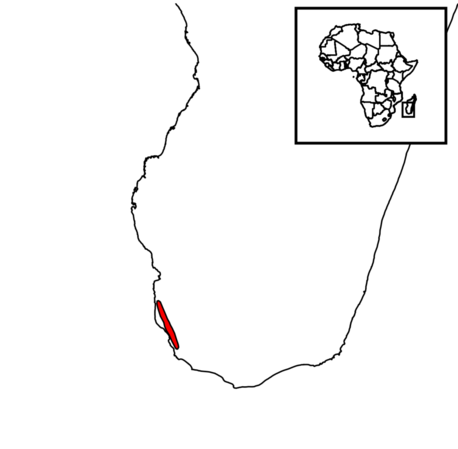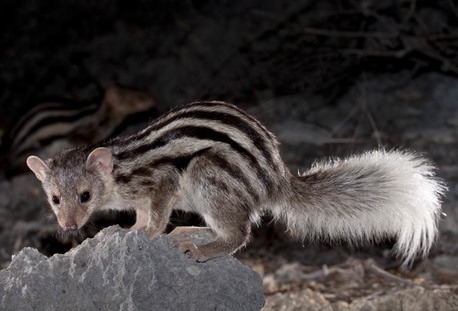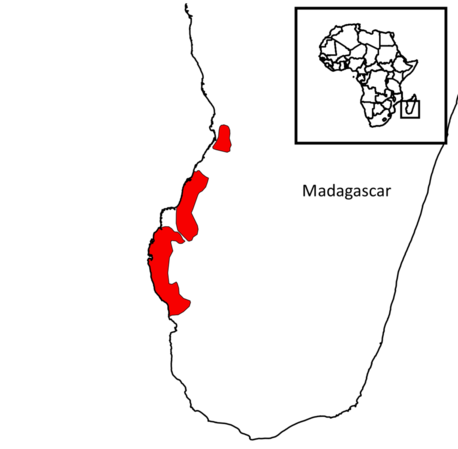African Small Carnivore Research Initiatives
- ASCaRIs Head Office, Sol Plaatje University, Natural and Applied Sciences Laboratory Building, Central Campus, Kimberley, Northern Cape, 8300, South Africa
- ascaris.org@gmail.com
Please lie down, relax and enjoy learning more about small carnivore diversity :-)
Africa is home to at least 80 species of small carnivores, that is species with an average adult body mass <15 kg. These belong to 8 different families: Canidae, Eupleridae, Felidae, Herpestidae, Hyaenidae, Mustelidae, Nandiniidae and Viverridae.
The sections below present distribution maps and short identity cards of each species. You can access the corresponding IUCN conservation status assessments by clicking on each species' status. You can also download full assessments with distribution maps and lists of countries where each species occurs.
Please see below details on how you can assist us in improving both this webpage and the current knowledge on African small carnivores. If you notice that one of your photographs is being used below and has not been duly credited, kindly contact us so that we can rectify this immediately. We acknowledge the use of the following sources to prepare these short species' ID cards: Carnivores of the World, Handbook of the Mammals of the World – Volume 1. Carnivores, and Mammals of Africa – Volume V. Carnivores, Pangolins, Equids and Rhinoceroses. Thank you to all of our colleagues who worked very hard to collect and analyse the data, or to collate and synthesize the information currently available on these species!
HB: head and body length 🔴 T: tail length 🔴 W: weight
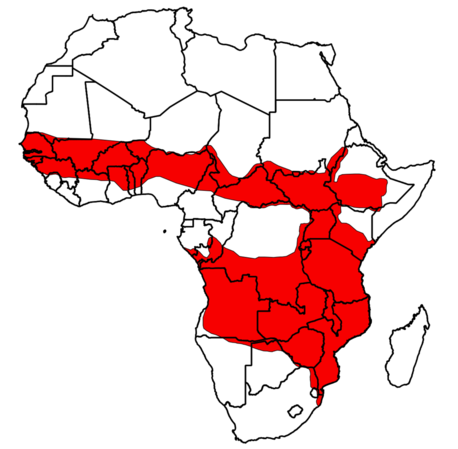
Research needs: Still to be identified and listed
Remark: Lupulella adusta recently suggested to be the correct scientific name
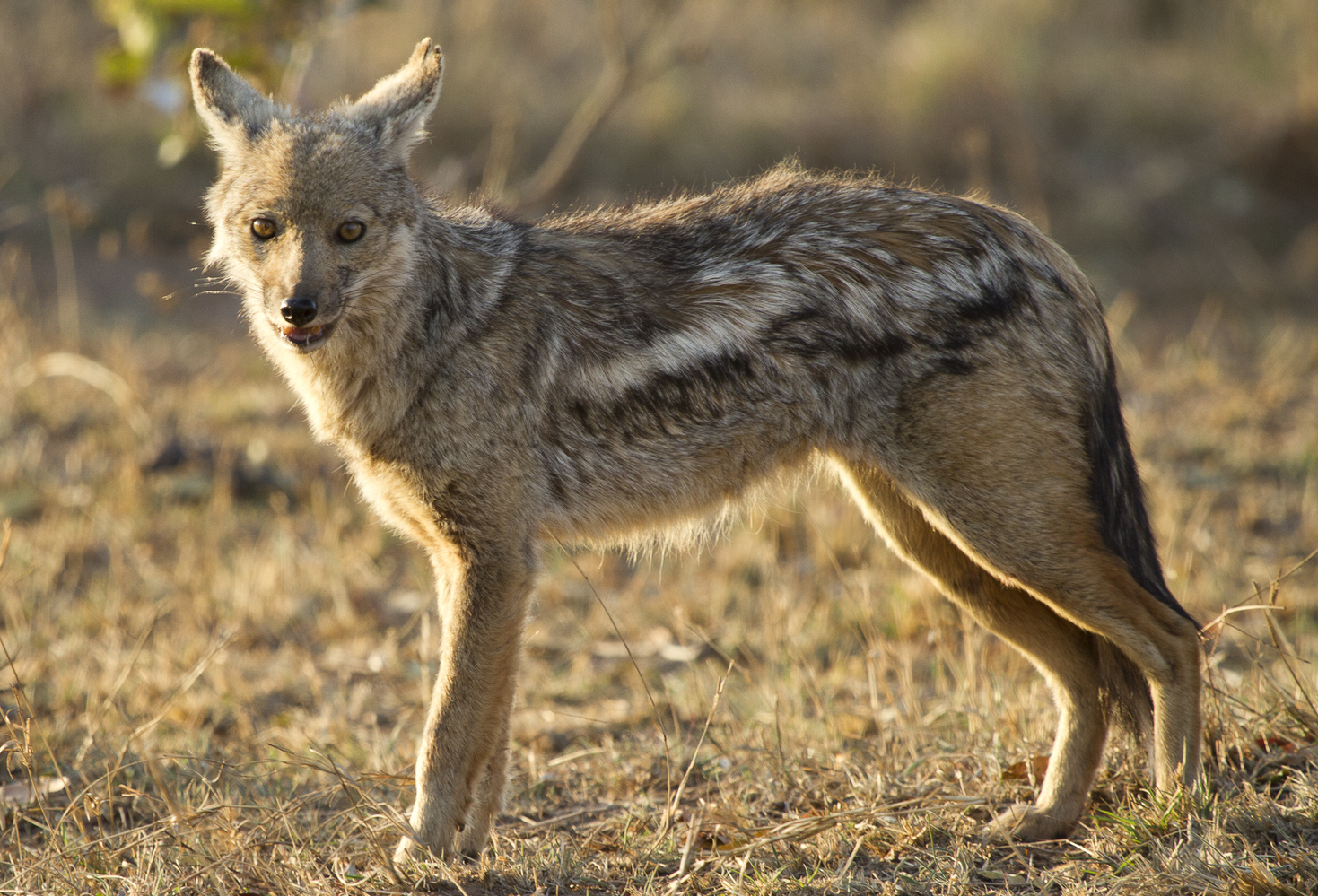
C1. Side-striped Jackal (Canis adustus)
HB: 65–81 cm 🔴 T: 30–41 cm 🔴 W: 5.9–12 kg
Distribution: West, Central and Southern Africa
Habitat: Wooded grassland, woodland savannah, marshland, montane areas and forest edges; peri-urban and urban areas
Diet: Omnivorous
Activity: Nocturnal; rarely crepuscular
Social behaviour: Pair + often yearlings (up to 7 individuals)
Home range: 0.15–1.6 km²
Density: 0.07–0.97 ind./km²
Threats: Human persecution, vehicles
IUCN population trend: Stable
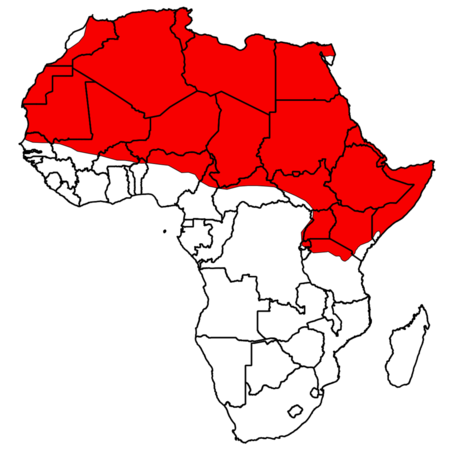
Research needs: xxx
Remark: Previously believed to be Canis aureus and later referred to as Canis anthus
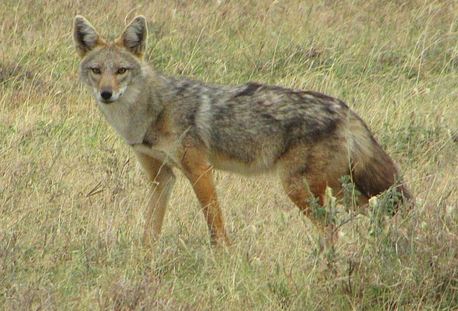
C2. African Golden Wolf (Canis lupaster)
HB: 74-84 cm 🔴 T: 20-24 cm 🔴 W: 6.5-9.8 kg
Distribution: Northern and Central East Africa
Habitat: Semi-desert, short to medium grasslands and savannahs
Diet: Omnivorous
Activity: Nocturnal, but flexible and may have diurnal activity periods
Social behaviour: Pair + sometime yearlings
Home range: 1.1-20 km²
Threats: Human persecution, vehicles
IUCN population trend: Increasing
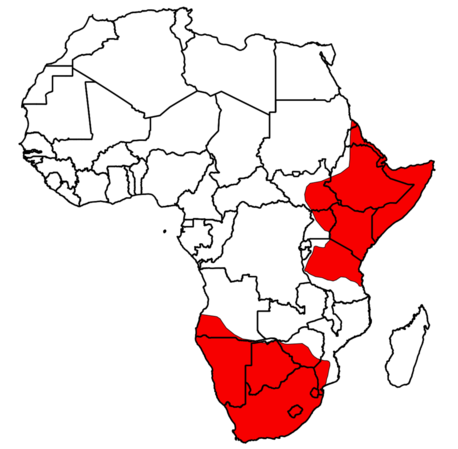
Research needs: Extensively studied. The main focus should be on solving human-jackal conflicts in farm areas
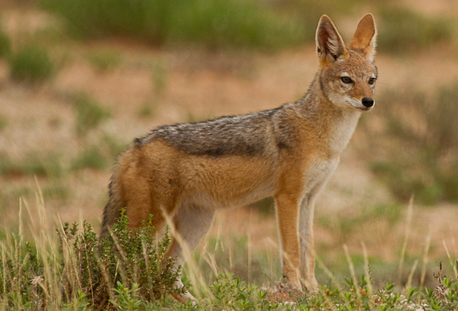
C3. Black-backed Jackal (Canis mesomelas)
HB: 65-90 cm 🔴 T: 26-39.5 cm 🔴 W: 5.9-12 kg
Distribution: Central East and Southern Africa
Habitat: Arid coastal desert, woodland to open grassland, farmland
Diet: Omnivorous
Activity: Nocturnal, but flexible and may have diurnal activity periods
Social behaviour: Pair + yearlings
Home range: 0.3-24.9 km²
Threats: Human persecution, vehicles
IUCN population trend: Stable

Research needs: xxx
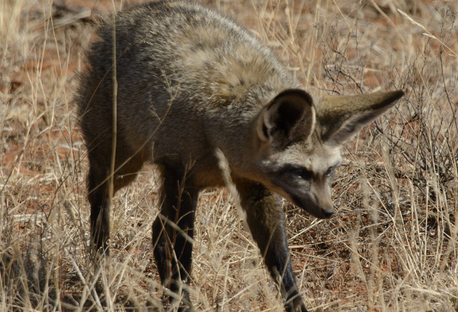
C4. Bat-eared Fox (Otocyon megalotis)
HB: 42.6-60.7 cm 🔴 T: 23-34 cm 🔴 W: 3.4-5.4 kg
Distribution: Southern and Eastern Africa
Habitat: Arid or semi arid grassland and open woodland savannah. Inhabits farmland and degraded habitat provided insecticide use is limited
Diet: Entirely insectivorous, but reptiles, rodents and fruits are also taken
Activity: Nocturnal, shift diurnal activity in winter
Social behaviour: Monogamous pair is typical, but extended groups maybe found
Home range: 1-8 km²
Threats: Insecticide kills of prey and disease outbreaks associated with domestic dogs
IUCN population trend: Stable
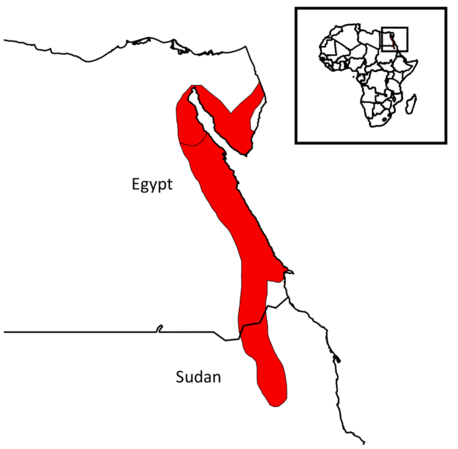
Research needs: xxx
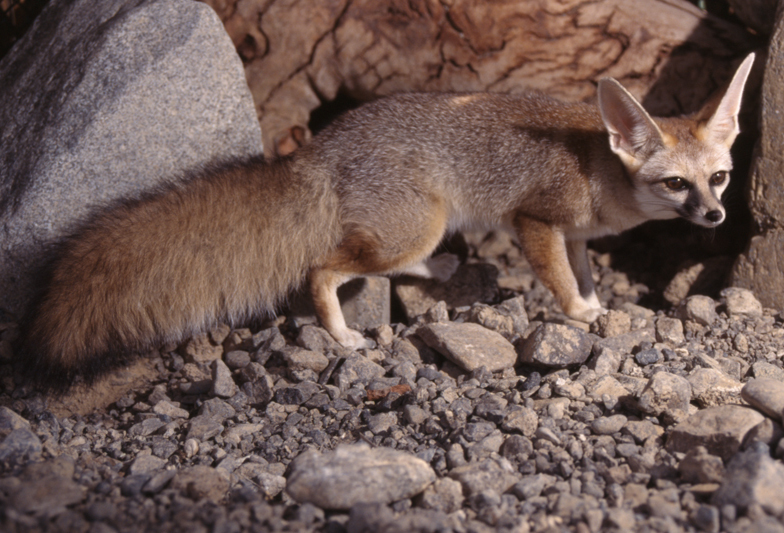
C5. Blanford's Fox (Vulpes cana)
HB: 34-47 cm 🔴 T: 26-36 cm 🔴 W: 0.8-1.6 kg
Distribution: Eastern Egypt, Arabian Peninsula and Central Asia
Habitat: Semi arid to arid rocky desert and mountainous habitats
Diet: Largely insectivorous and frugivorous, but small rodents, birds, reptiles and probably carrion are also taken
Activity: Nocturnal, increased crepuscularity in winter
Social behaviour: Solitary + pairs in breeding period
Home range: 0.5-2 km²
Threats: Habitat development and poison
IUCN population trend: Stable
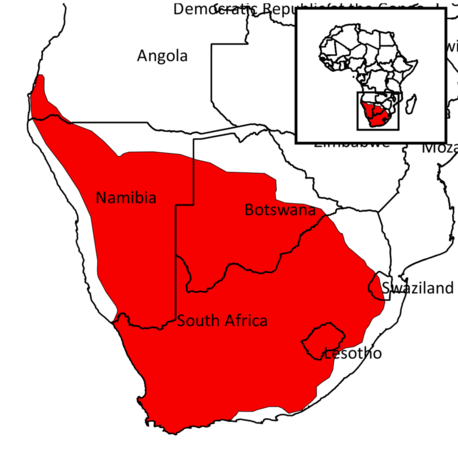
Research needs: xxx
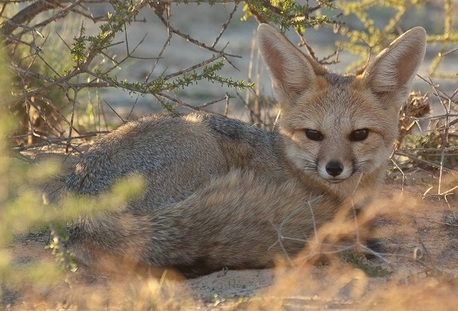
© E. Do Linh San*
C6. Cape Fox (Vulpes chama)
HB: 45-61 cm 🔴 T: 25-40.6 cm 🔴 W: 2-3.3 kg
Distribution: Southern Africa
Habitat: Semi arid and arid habitats, extending into moderately mesic scrub habitat, farmland
Diet: Mainly mice and gerbils, but small birds, reptiles, invertebrates, fruits, hares and springhares and carrion livestock are also taken
Activity: Nocturnal
Social behaviour: Solitary+ pairs in breeding period
Home range: 1-32.1 km²
Threats: Killing by humans
IUCN population trend: Stable
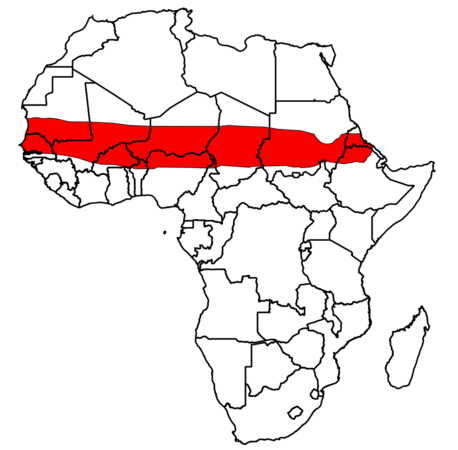
Research needs: xxx

© Name Surname
C7. Pale Fox (Vulpes pallida)
HB: 38-55 cm 🔴 T: 23-28.5 cm 🔴 W: 1.2-3.6 kg
Distribution: Sub-Saharan Africa
Habitat: Arid, sandy and stony deserts, and dry savannah
Diet: Primarily insectivorous, scorpions, small mammals, fruits, seeds and plant matter are also taken
Activity: Nocturnal
Social behaviour: Mostly seen in pairs and small groups
Home range: 5.6 km²
Threats: Killed near settlement and used locally for traditional medicines
IUCN population trend: Unknown
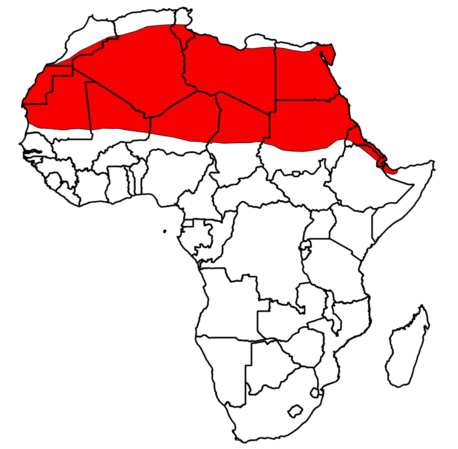
Research needs: xxx

© A. Sliwa
C8. Rüppell's Fox (Vulpes rueppellii)
HB: 35-56 cm 🔴 T: 25-39 cm 🔴 W: 1.1-2.3 kg
Distribution: Northern Africa, The Arabian Peninsula and Central Asia
Habitat: Semi arid to very arid habitats, including sandy and stony deserts, rocky steppes, massifs, scrub, vegetated watercourses and near human habitation
Diet: Omnivorous: small mammals, birds, lizards, insects and plant matter
Activity: Nocturno-crepuscular
Social behaviour: Solitary + pairs in breeding period but larger aggregation of up to 15 suggest more complex sociality
Home range: 20.9-84.4 km² (♂︎) 🔴 13.2-53.8 km² (♀)
Threats: killed indiscriminately during poisoning campaigns and absent in heavily grazed area
IUCN population trend: Stable
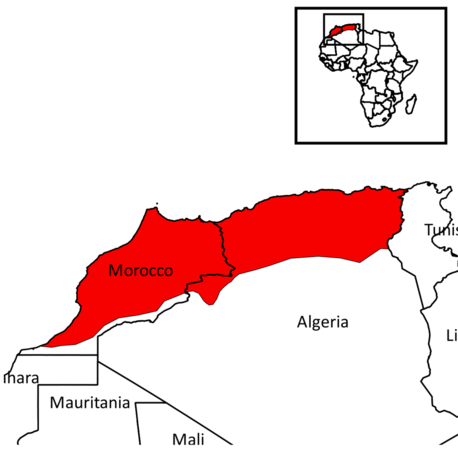
Research needs: Extensively studied in Eurasia and North America, but little is known about its behaviour and ecology in North Africa
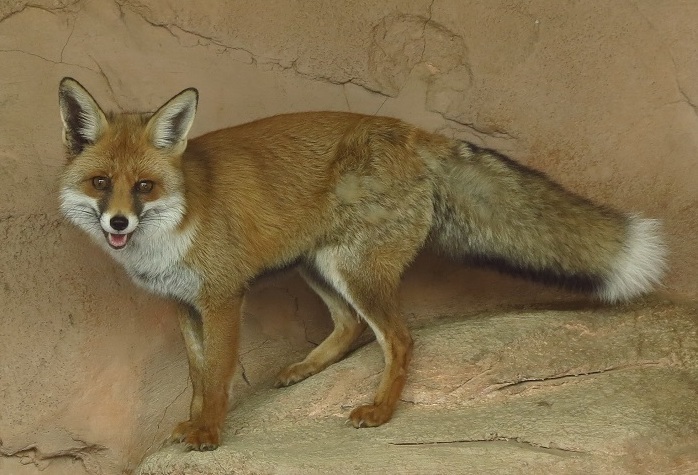
C9. Red Fox (Vulpes vulpes)
HB: 45-90 cm 🔴 T: 28-49 cm 🔴 W: 3.4-14 kg
Distribution: North America, Eurasia and North Africa
Habitat: Farmland, suburbs and cities north of the Tropic of Cancer, except the northernmost Arctic and deserts of the Southwestern USA
Diet: Highly opportunistic eating reptiles, birds, small mammals, hairs, eggs, amphibians, fish, invertebrates, juvenile small stock, poultry, fruits and plant matter
Activity: Nocturno-crepuscular, shift diurnal activity in winter and where it is undisturbed
Social behaviour: Solitary + sociality in breeding period is very flexible
Home range: 0.2-50 km²
Threats: Killed for the fur, sports hunter and pest control
IUCN population trend: Stable

Research needs: xxx
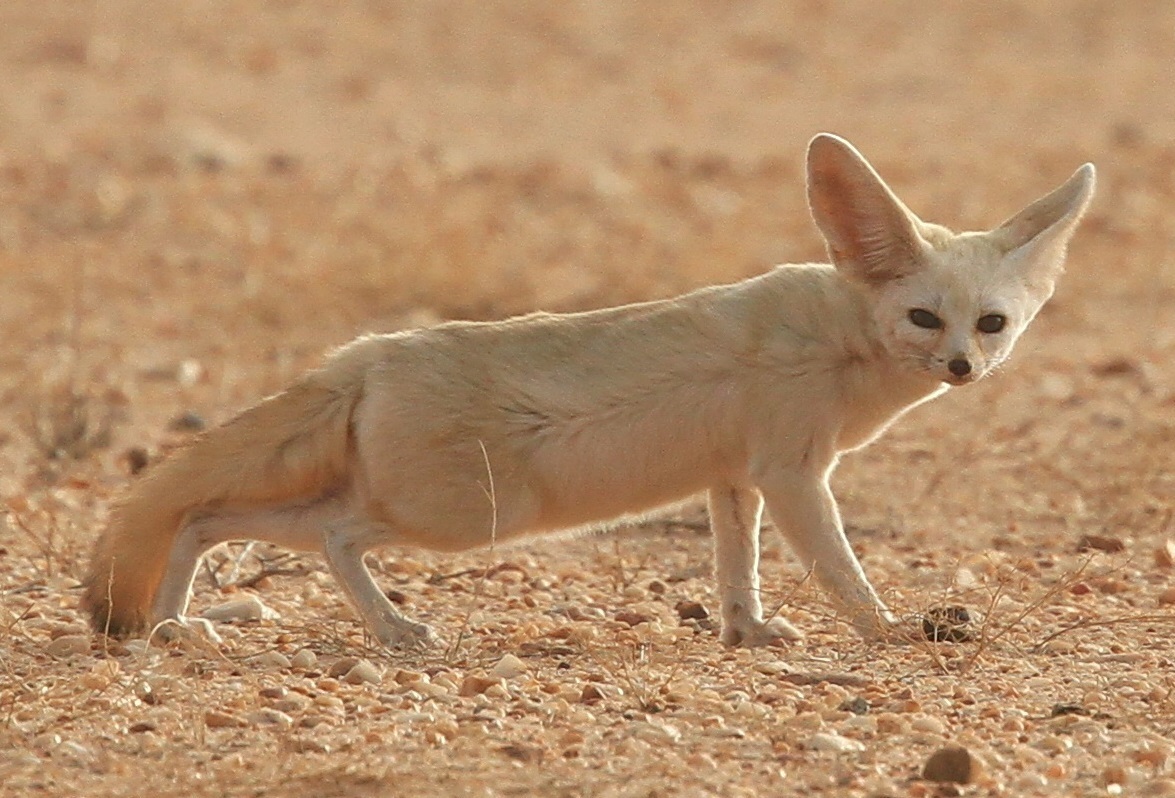
C10. Fennec Fox (Vulpes zerda)
HB: 33.5-39.5 cm 🔴 T: 12.5-23 cm 🔴 W: 0.8-1.9 kg
Distribution: Restricted to North Africa
Habitat: Adapted to deserts
Diet: Small rodents, lizards, birds, invertebrates, fruits, poultry and eggs
Activity: Nocturnal, but crepuscular-diurnal in winter
Social behaviour: Poorly known
Home range: Nothing known
Threats: Trapping for the tourist pet and domestic fur trades
IUCN population trend: Stable
E1. Fossa (Cryptoprocta fossa)
HB: 70-80 cm 🔴 T: 61-70 cm 🔴 W: 5.5-8.6 kg
Distribution: Madagascar
Habitat: Forest and woodland
Diet: Primates, but rodents, Narrow-striped Boky, Fanaloka, birds, reptiles, amphibians, invertebrates, chickens and carrion are also taken
Activity: Cathemeral
Social behaviour: Solitary
Home range: 27 km² (♂) 🔴 13 km² (♀)
Threats: : Forest loss and fragmentation, human hunting for meat, feral domestic dogs impact on densities and the species is vulnerable to exotic diseases from dogs and cats
IUCN population trend: Decreasing
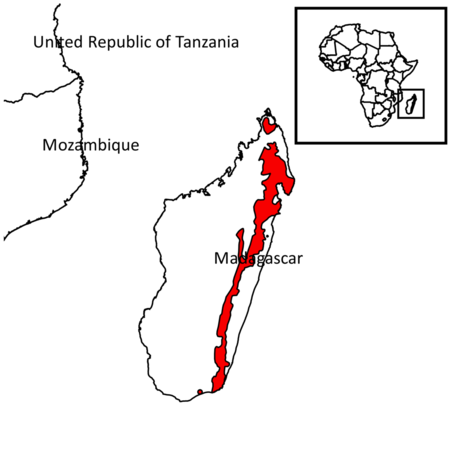
Research needs: xxx

© Name Surname
E2. Eastern Falanouc (Eupleres goudotii)
HB: 45.5-49.5 cm 🔴 T: 22-24 cm 🔴 W: 1.6-2.1 kg
Distribution: Northwestern Madagascar
Habitat: Humid and deciduous forests and associated marshland from sea-level to 1600 m. Also recorded from mesic, open grassy patches in forest, and from fragmented, degraded forest habitat
Diet: Exclusively insectivorous/vermivorous
Activity: Cathemeral
Social behaviour: Solitary
Home range: Nothing known
Threats: Habitat loss and bushmeat hunting
IUCN population trend: Decreasing
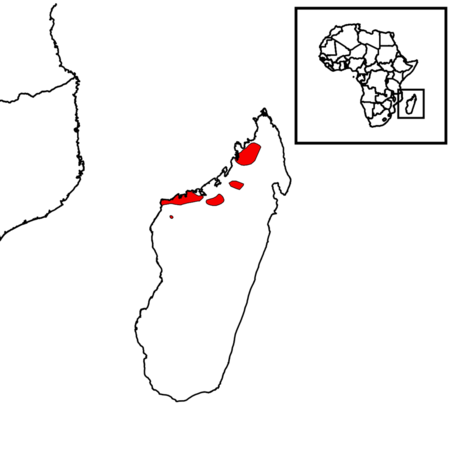
Research needs: Spatial ecology

© Name Surname
E3. Western Falanouc (Eupleres major)
HB: 51.5-65 cm 🔴 T: 24-25 cm 🔴 W: 2.8-4.6 kg
Distribution: Northwestern Madagascar
Habitat: Humid and deciduous forests and associated marshland from sea-level to 1600m. Also recorded from mesic, open grassy patches in forest, and from fragmented, degraded forest habitat
Diet: Exclusively insectivorous/vermivorous
Activity: Cathemeral
Social behaviour: Solitary
Home range: Nothing known
Threats: Habitat loss and bushmeat hunting
IUCN population trend: Decreasing
E4. Spotted Fanaloka (Fossa fossana)
HB: 40-45 cm 🔴 T: 21-46.4 cm 🔴 W: 1.3-1.9 kg
Distribution: Northern and Eastern Madagascar
Habitat: Humid and dry forests
Diet: Rodents, small birds, reptiles, amphibians and invertebrates
Activity: Nocturnal
Social behaviour: Solitary
Home range: 0.07-0.52 km²
Threats: Habitat fragmentation and human hunting
IUCN population trend: Decreasing
E5. Ring-tailed Vontsira (Galidia elegans)
HB: 30-38 cm 🔴 T: 26-39.1 cm 🔴 W: 0.66-1.09 kg
Distribution: Madagascar
Habitat: Forests
Diet: Rodents, tenrecs, reptiles, birds and eggs, invertebrates, but aquatic prey and lemur are also taken
Activity: Diurnal
Social behaviour: Unclear if pairs form only for breeding
Home range: 0.2-0.25 km² (♂)
Threats: Persecuted for killing poultry, killed by dogs and bushmeat hunting
IUCN population trend: Decreasing
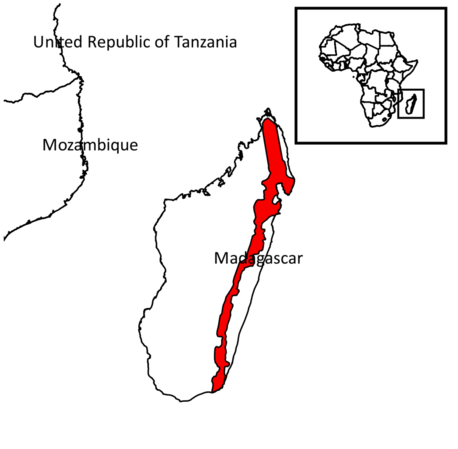
Research needs: Spatial ecology

© Name Surname
E6. Broad-striped Vontsira (Galidictis fasciata)
HB: 30-34 cm 🔴 T: 25-29.3 cm 🔴 W: 0.52-0.74 kg
Distribution: Eastern Madagascar
Habitat: Forest
Diet: Insects, arachnids, small vertebrates, Lesser Hedgehog Tenrec, Madagascar Turtle-dove, snakes and chickens
Activity: Nocturnal
Social behaviour: Adult pairs (up to 5 individuals)
Home range: Nothing known
Threats: Habitat loss, hunting for bushmeat, small Indian civet and domestic dog
IUCN population trend: Decreasing
E7. Grandidier’s Vontsira (Galidictis grandidieri)
HB: 39.5-48 cm 🔴 T: 28-32.5 cm 🔴 W: 1.2-2.3 kg
Distribution: Eastern Madagascar
Habitat: Forests
Diet: Insects, arachnids, small vertebrates, Lesser Hedgehog Tenrec, Madagascar Turtle-dove, snakes and chickens
Activity: Nocturnal
Social behaviour: Adult pairs (up to 5 individuals)
Home range: Nothing known
Threats: Habitat loss, hunting for bushmeat, small Indian civet and domestic dog
IUCN population trend: Decreasing
E8. Bokiboky (Mungotictis decemlineata)
HB: 26.4-29.4 cm 🔴 T: 19.1-21.5 cm 🔴 W: 0.45-0.74 kg
Distribution: Southwestern Madagascar
Habitat: Dry deciduous and baobab forests
Diet: Mainly Insects, snail, small reptiles, eggs, but rodents, tenrecs, dwarf lemurs and scavenging of large preys are also taken
Activity: Diurnal
Social behaviour: Complex sociality (2-4 individuals)
Home range: 0.5-1.3 km² (♂) 🔴 0.24-0.6 km² (♀)
Threats: Habitat loss and bushmeat hunting
IUCN population trend: Decreasing
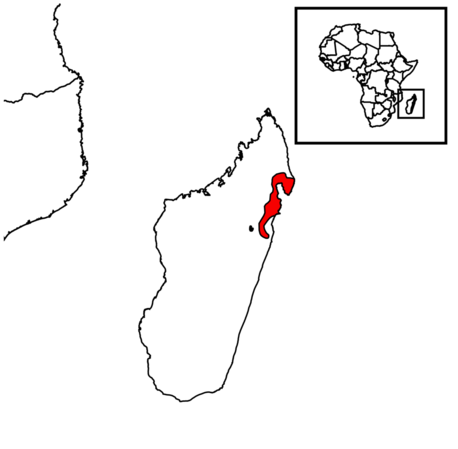
Research needs: Spatial ecology

© Name Surname
E9. Brown-tailed Vontsira (Salanoia concolor)
HB: 35-38 cm 🔴 T: 16-20 cm 🔴 W: 0.78 kg
Distribution: Northeastern Madagascar
Habitat: Rainforest, forest and cultivated land
Diet: Mainly insectivorous
Activity: Diurnal
Social behaviour: Groups (up to 5 individuals)
Home range: Nothing known
Threats: Deforestation and bushmeat hunting
IUCN population trend: Decreasing
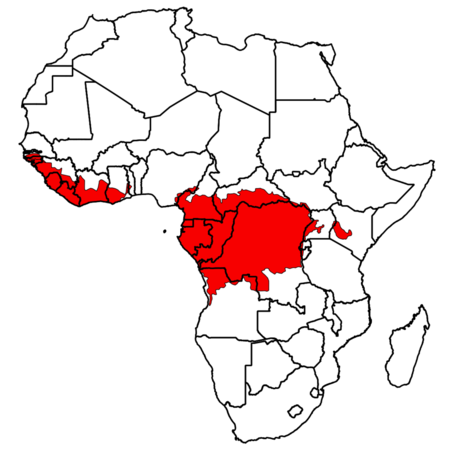
Research needs: Socio-spatial ecolo

F1. Golden Cat (Caracal aurata)
HB: 61.6-101 cm 🔴 T: 16.3-34.9 cm 🔴 W: 6-16 kg
Distribution: Western Africa
Habitat: Moist forests along rivers, logged forest with understory
Diet: Mainly small ungulates, birds are also taken
Activity: Primarily crepuscular but some nocturnal and diurnal activity has been recorded
Social behaviour: Nothing known
Home range: Nothing known
Threats: Habitat fragmentation and human persecution
IUCN conservation status: Vulnerable (VU)
IUCN population trend: Decreasing

Research needs: Comparatively well studied. The main focus should be on solving human-caracal conflicts in farm areas
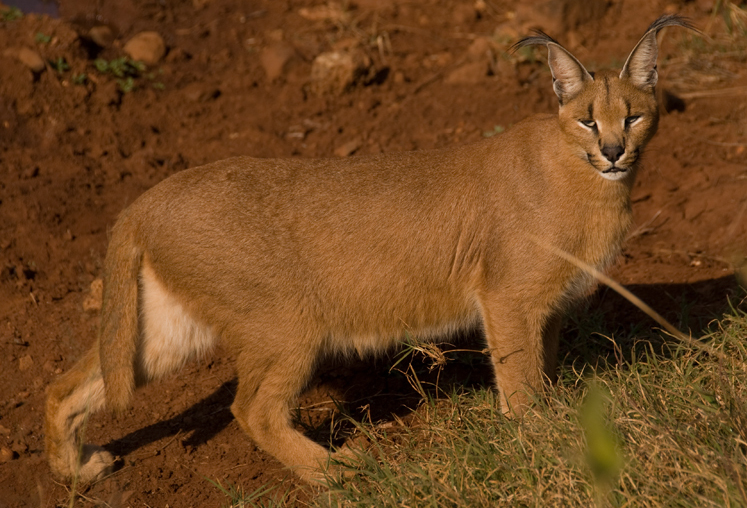
F2. Caracal (Caracal caracal)
HB: 61-105.7 cm 🔴 T: 19.5-34 cm 🔴 W: 6.2-20 kg
Distribution: All Africa, except Sahara desert and Western region
Habitat: Dry woodlands, savannahs, acacia scrubs and arid mountain areas
Diet: Hares, hyrax, rodents and birds
Activity: Mainly nocturnal but crepuscular activity has been recorded
Social behaviour: Solitary + pairs
Home range: 15.2-220 km² (♂) 🔴 5.5-57 km² (♀)
Threats: Habitat fragmentation, human persecution
IUCN conservation status: Least Concern (LC)
IUCN population trend: Unknown
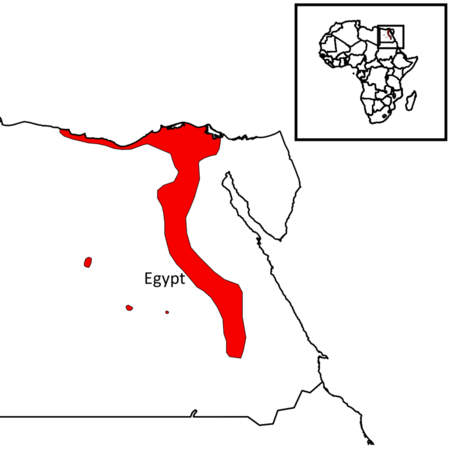
Research needs: Socio-spatial ecology, persecution levels and pet trade
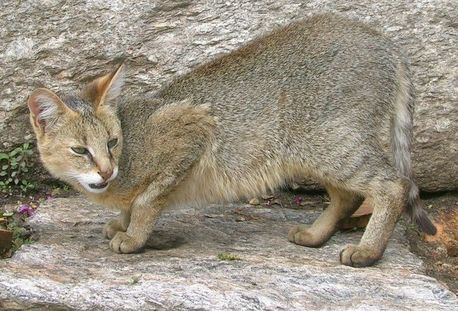
Unknown source
F3. Jungle Cat (Felis chaus)
HB: 61-85 cm 🔴 T: 20-31 cm 🔴 W: 2.6-12 kg
Distribution: Nil river valley in Egypt
Habitat: Tall grasslands, thick bush, riverine swamps and reed beds
Diet: Mainly small mammals, birds, reptiles and frogs were recored
Activity: Nocturnal, but crepuscular activity has been recorded
Social behaviour: Nothing known
Home range: Nothing known
Threats: Human persecution (pelt)
IUCN conservation status: Least Concern (LC)
IUCN population trend: Decreasing

Research needs: Spatial ecology
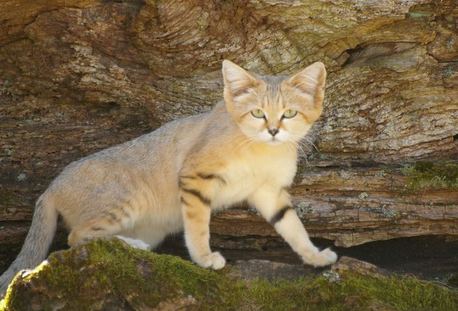
Unknown source
F4. Sand Cat (Felis margarita)
HB: 39-52 cm 🔴 T: 23.2-31 cm 🔴 W: 1.4-3.4 kg
Distribution: North Africa in most of Sahara desert
Habitat: Undulated stabelized dune areas, dry river beds and open steppes with sparse grass and shrubs
Diet: Mainly small desert rodents, reptiles and insects
Activity: Nocturnal, some diurnal activity in winter months
Social behaviour: Solitary
Home range: Check Sliwa et al. (2023)
Threats: Human persecution, competition from introduced and feral domestic (cats and dogs) species
IUCN population trend: Unknown

Research needs: Well studied at a single location in South Africa. Comparative data from across the distribution range are needed.

Unknown source
F5. Black-footed Cat (Felis nigripes)
HB: 36-52 cm 🔴 T: 16.6-20 cm 🔴 W: 1-2.5 kg
Distribution: Southern Africa
Habitat: Dry open savannah and grasslands and Karoo semi-desert
Diet: Mainly small mammals, but also eats invertebrates, reptiles and birds
Activity: Nocturnal and crepuscular
Social behaviour: Solitary, except during mating season
Home range: 9.5-17.6 km²
Threats: Habitat fragmentation, human persecution, poisoning
IUCN conservation status: Vulnerable (VU)
IUCN population trend: Decreasing
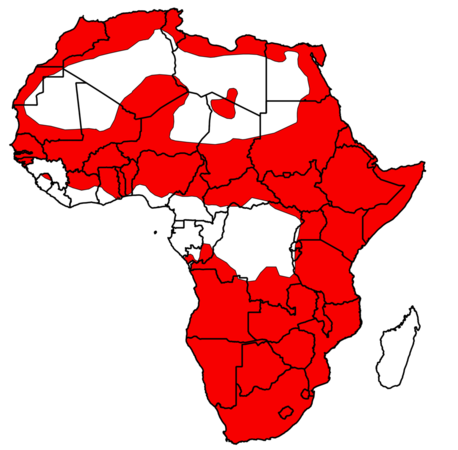
Research needs: Lack of studies in African populations.
Remark: Treated as a separate species, Felis lybica, by some authors
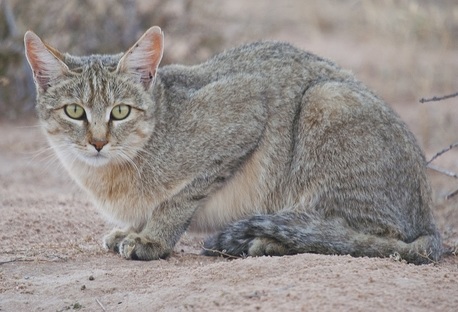
© E. Do Linh San
F6. Wild Cat (Felis silvestris)
HB: 40.6-66.5 cm 🔴 T: 24.1-36.8 cm 🔴 W: 2.4-6.4 kg
Distribution: Africa, except Sahara desert
Habitat: Open woodlands and grasslands, scrub areas near water
Diet: Murids rodents, hares and rabbits are sometimes taken
Activity: Nocturnal, but can be crepuscular in remote areas
Social behaviour: Solitary
Home range: 1.6-52.7 km²
Threats: Human persecution, hybridization with feral and domestic cats, vehicles
IUCN population trend: Decreasing

Research needs: xxx
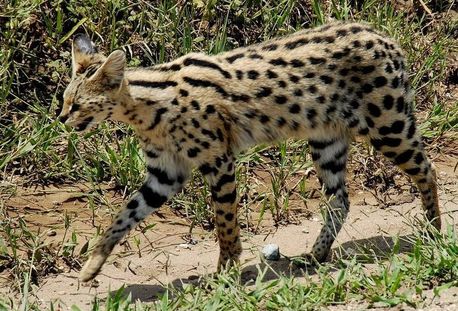
Unknown source
F7. Serval (Leptailurus serval)
HB: 59-92 cm 🔴 T: 20-38 cm 🔴 W: 7-13.5 kg
Distribution: Morocco, Central and East southern Africa
Habitat: Grasslands and savanahs, riverine habitats near water
Diet: Small mammals, hares, birds, reptiles and frogs are also taken
Activity: Nocturnal and crepuscular
Social behaviour: XXXXXXXXXXXXXXXXXX
Home range: 9.5-31.5 km²
Threats: Human persecution
IUCN population trend: Stable

Research needs: Well studied, particularly their diet. Comparative data from across their range are needed.
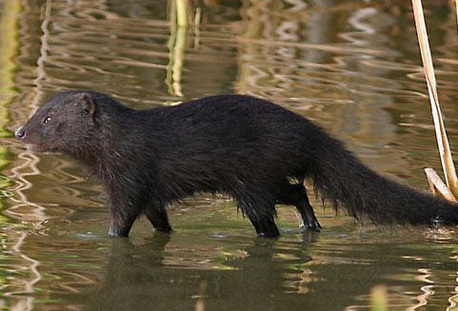
H1. Marsh Mongoose (Atilax paludinosus)
HB: 48.7-51.4 cm 🔴 T: 31-41 cm 🔴 W: 2.4-4.1 kg
Distribution: Western, Eastern and Southern Africa
Habitat: Riparian habitats, swamp forests, estuarine and coastal areas
Diet: Opportunistic, crabs, fish, insects, mammals and reptiles
Activity: Nocturnal and crepuscular
Social behaviour: Solitary + pairs are also seen
Home range: 131-204 ha
Threats: Habitat fragmentation and human persecution (bushmeat)
IUCN conservation status: Least Concern (LC)
IUCN population trend: Decreasing
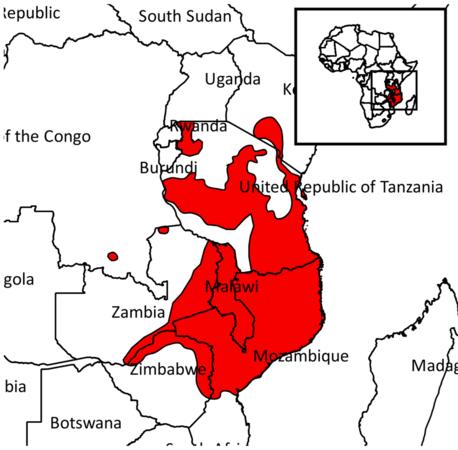
Research needs: Spatial ecology

© Name Surname
H2. Bushy-tailed Mongoose (Bdeogale crassicauda)
HB: 40-50 cm 🔴 T: 18-30 cm 🔴 W: 1.3-2.1 kg
Distribution: Eastern Africa, mainly in Tanzania and Mozambique
Habitat: Wooded grasslands, montane forests and riverine forests
Diet: Mainly insects, but small mammals and reptiles also taken
Activity: Nocturnal
Social behaviour: Solitary + some pairs recorded
Home range: Nothing known
Threats: Habitat fragmentation
IUCN conservation status: Least Concern (LC)
IUCN population trend: Unknown

Research needs: Spatial ecology

© Name Surname
H3. Jackson's Mongoose (Bdeogale jacksoni)
HB: 50.8-57.1 cm 🔴 T: 28.3-32.4 cm 🔴 W: 2-3 kg
Distribution: Kenya, SE Uganda and confirmed in Tanzania
Habitat: Montane forests, bamboo areas and lowland forests
Diet: Mainly small mammals, but insects, reptiles and eggs also taken
Activity: Nocturnal
Social behaviour: Solitary, but groups were also recorded
Home range: Nothing known
Threats: Forest loss and fragmentation
IUCN conservation status: Near Threatened (NT)
IUCN population trend: Decreasing
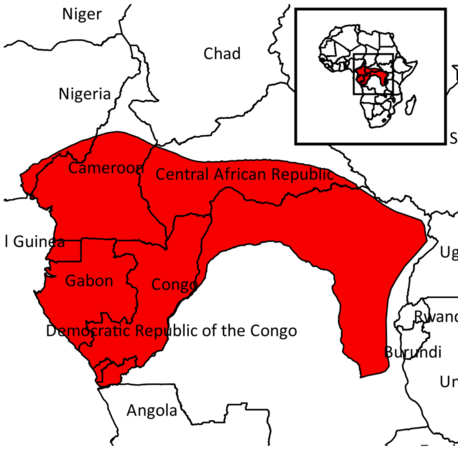
Research needs: Spatial ecology

© Name Surname
H4. Black-legged Mongoose (Bdeogale nigripes)
HB: 45-65 cm 🔴 T: 29-40 cm 🔴 W: 2-4.8 kg
Distribution: Central East of Africa
Habitat: Rain forests
Diet: Omnivorous, mainly arthropodes, but small mammals, reptiles, amphibians and fruits also taken
Activity: Nocturnal, but some diurnal activity recorded
Social behaviour: Solitary
Home range: Nothing known
Threats: Forest losss and fragmentation and bushmeat
IUCN conservation status: Least Concern (LC)
IUCN population trend: Decreasing
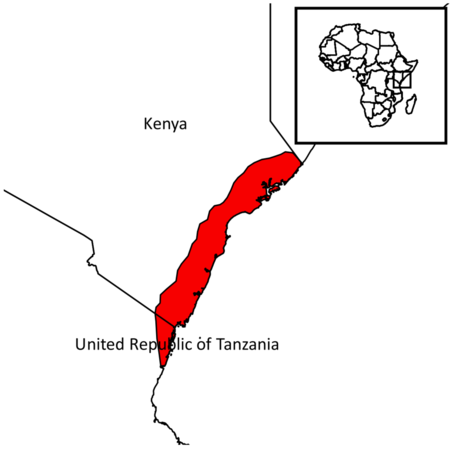
Research needs: Spatial ecology

© Name Surname
H5. Sokoke Bushy-tailed Mongoose (Bdeogale omnivora)
HB: 40-50 cm 🔴 T: 18-30 cm 🔴 W: 1.3-2.1 kg
Distribution: Eastern Africa, from Southern Kenya to Northern Zimbabwe and West to Southern DR Congo
Habitat: Dense woodland savannah, dry and wet forests, wooded grassland and hilly areas with rocky or shrubby cover
Diet: Insects, small reptiles, frogs, tods, land snails, scorpions, other arachnids, but rodents and snakes are also taken
Activity: Nocturnal
Social behaviour: Solitary
Home range: Nothing known
Threats: Illegal logging and hunting
IUCN population trend: Decreasing
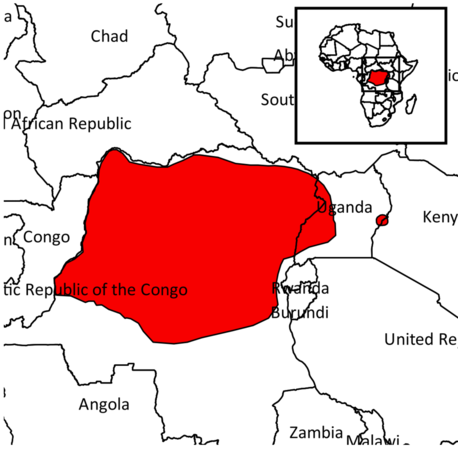
Research needs: Spatial ecology and social behaviour

© Name Surname
H6. Alexander's Cusimanse (Crossarchus alexandri)
HB: 35-44 cm 🔴 T: 20.8-32 cm 🔴 W: 1-2 kg
Distribution: DR Congo and Western Uganda
Habitat: Lowland, montane rainforests, swampy areas, near village and cultivated areas
Diet: Invertebrates, small vertebrates and some fruits
Activity: Diurnal
Social behaviour: Highly social (up to 10 individuals)
Home range: Nothing known
Threats: Habitat loss and bushmeat hunting
IUCN population trend: Decreasing
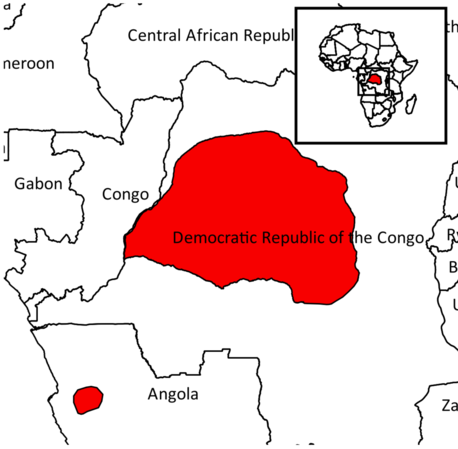
Research needs: Spatial ecology and social behaviour

© Name Surname
H7. Angolan Cusimanse (Crossarchus ansorgei)
HB: 32-36 cm 🔴 T: 20.8-22 cm 🔴 W: 0.6-1.5 kg
Distribution: Western DC Congo and Northwestern Angola
Habitat: Rainforest
Diet: Invertebrates and small vertebrates
Activity: Diurnal
Social behaviour: Highly social (up to 20 individuals)
Home range: Nothing known
Threats: Bushmeat hunting
IUCN population trend: Decreasing
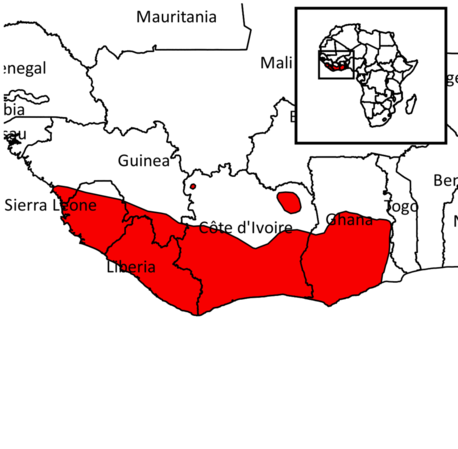
Research needs: Social behaviour
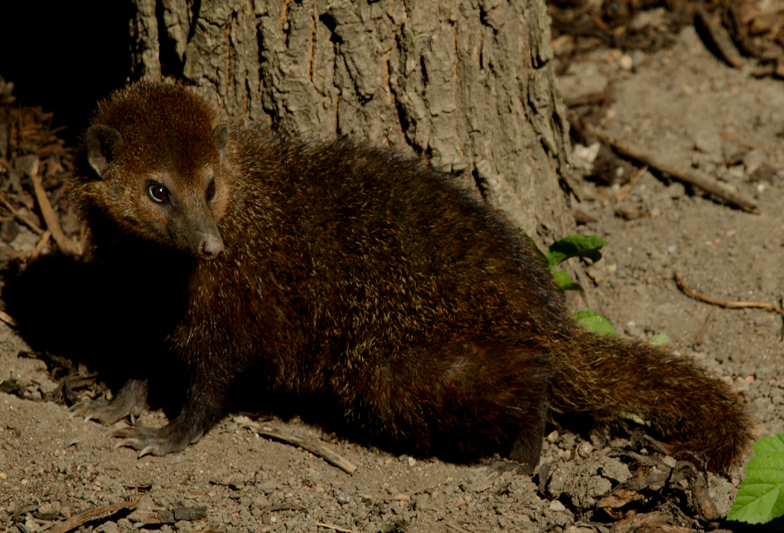
H8. Common Cusimanse (Crossarchus obscurus)
HB: 30-37 cm 🔴 T: 14.6-21 cm 🔴 W: 0.45-1 kg
Distribution: Western Guinea and Sierra Leone to the Ghana-Togo border
Habitat: Understorey of rainforest and riparian forest
Diet: Mainly invertebrates, but rodents, cobras, small birds, herptiles, eggs and fruits are also taken
Activity: Diurnal
Social behaviour: Highly social (up to 20 individuals)
Home range: 0.28-1.4 km² per group
Threats: Human pressure and bushmeat hunting
IUCN population trend: Unknown
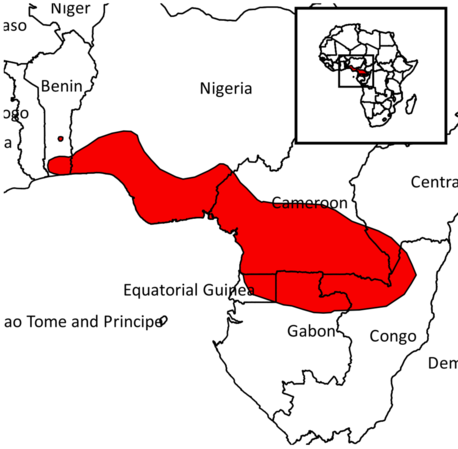
Research needs: Spatial ecology and social behaviour

© Name Surname
H9. Flat-headed Cusimanse (Crossarchus platycephalus)
HB: 30-36 cm 🔴 T: 15.6-21 cm 🔴 W: 0.5-1.5 kg
Distribution: Southern Nigeria through Southern Cameroon and the extreme Southwest of the Central African Republic reaching Equatorial Guinea, northern Gabon and the northwest Republic of the Congo
Habitat: Rainforest, forest-savannah mosaics and forest farmland
Diet: Invertebrates, small vertebrates and freshwater crabs
Activity: Diurnal
Social behaviour: Highly social (usually 5-8 members, but up to 25 individuals)
Home range: Nothing known
Threats: Bushmeat hunting
IUCN population trend: Unknown

Research needs: Well studied. Comparative data from across their range are needed
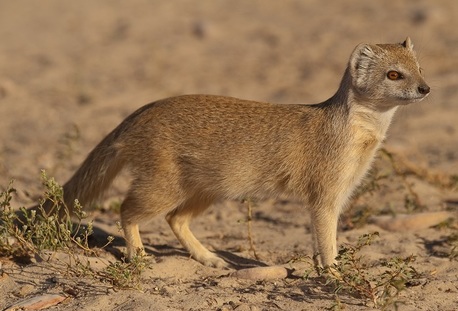
© E. Do Linh San
H10. Yellow Mongoose (Cynictis penicillata)
HB: 27-46 cm 🔴 T: 25-29 cm 🔴 W: 0.44-0.9y kg
Distribution: Southern Africa
Habitat: Semi-desert, grassland, fynbos heath, scrubland and open bushland
Diet: Mainly insectivorous, but invertebrates, small vertebrates, domestic poultry eggs, carrion and fruits are also taken
Activity: Diurnal
Social behaviour: Family groups (3-4 up to 13 individuals)
Home range: 1.09 km² (♂) 🔴 0.1-49 km² (♀)
Threats: Wholesale eradication campaigns to control rabies
IUCN population trend: Stable
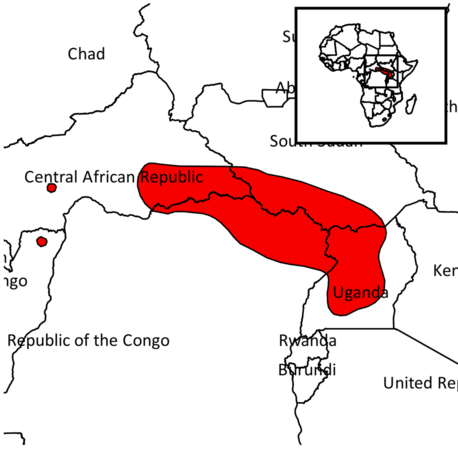
Research needs: Diet, spatio-temporal ecology, social behaviour, threats

© Name Surname
H11. Pousargues's mongoose (Dologale dybowskii)
HB: 25-33 cm 🔴 T: 16-23 cm 🔴 W: 0.3-0.4 kg
Distribution: Northwestern Uganda, Northeastern Democratic Republic of the Congo, Southern Central African Republic and Southern South Sudan
Habitat: Dry savannah, savannah-forest mosaics and montane-forest grassland
Diet: Invertebrates and seeds
Activity: Diurnal
Social behaviour: Solitary, but groups are found (up to 8 individuals)
Home range: Nothing known
Threats: Nothing known
IUCN population trend: Unknown

Research needs: Extensive research needed

© Name Surname
H12. Somali Dwarf Mongoose (Helogale hirtula)
HB: 20-27 cm 🔴 T: 15-18 cm 🔴 W: 0.22-0.35 kg
Distribution: Somalia, Southeastern Ethiopia and Eastern Kenya; possibly Djibouti and extreme Northeastern Tanzania
Habitat: Arid to semi-arid open woodlands, scrub and grassland
Diet: Nothing known
Activity: Nothing known
Social behaviour: Large groups
Home range: Nothing known
Threats: Unknown
IUCN population trend: Unknown

Research needs: Well studied. Comparative data from across their range are needed

© E. Do Linh San
H13. Common Dwarf Mongoose (Helogale parvula)
HB: 16-23 cm 🔴 T: 14.2-18.2 cm 🔴 W: 0.21-0.34 kg
Distribution: From the Horn of Africa through Eastern Africa, Southern DR Congo, Mozambique, Zambia, and Angola to Northern Namibia
Habitat: Dry and wet woodland savannah, brush, scrubland and open forest
Diet: Insects, scorpions, small mammals, reptiles, frogs, birds, eggs and fruits
Activity: Diurnal
Social behaviour: Family groups (2-32 individuals)
Home range: 0.27-0.96 km² /group
Threats: Does not suffer major threats
IUCN population trend: Stable
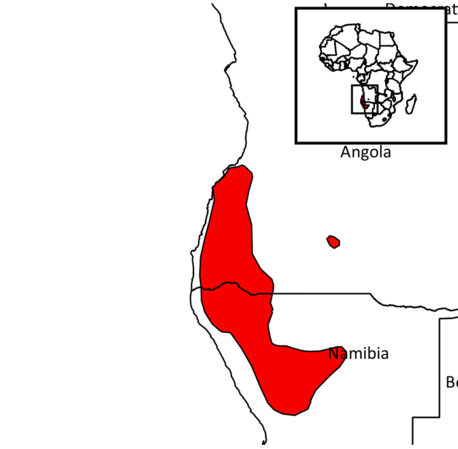
Research needs: xxx

© Name Surname
H14. Angolan Slender Mongoose (Herpestes flavescens)
HB: 31-35.5 cm 🔴 T: 31-37 cm 🔴 W: 0.55-0.9 kg
Distribution: Southwestern Angola and Northwestern Namibia
Habitat: Arid habitats with cover
Diet: Mainly Small rodents, insects, but reptiles, arachnids, eggs and seeds are also taken
Activity: Diurnal
Social behaviour: Solitary, but males occasionally form loose pairs
Home range: 0.13-1.45 km² (♂)
Threats: No serious threats
IUCN population trend: Unknown
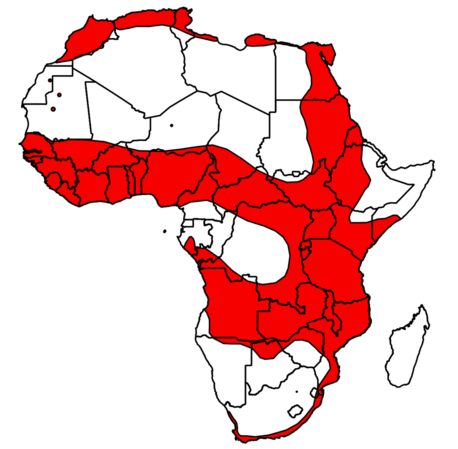
Research needs: xxx
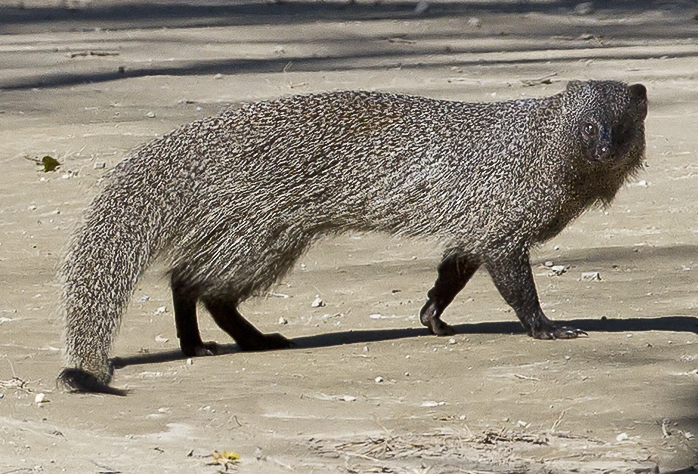
H15. Large Grey Mongoose (Herpestes ichneumon)
HB: 50-61 cm 🔴 T: 43.5-58 cm 🔴 W: 2.2-4.1 kg
Distribution: Most of Africa except the Sahara also the Spain and Portugal (possibly introduced) and the Middle East
Habitat: Woodland, grassland, wetland, semi-desert montane area, plus cultivated land and farmland
Diet: Vertebrates to the size of hares, poultry, invertebrates, fruits and fungi and scavenges from carrion
Activity: Nocturno-crepuscular
Social behaviour: Generally solitary, but small groups are found (up to 1 male with 1-3 females and their offspring)
Home range: 0.38-3.1 km²
Threats: Human persecution and poisoning of rodent prey
IUCN population trend: Stable

Research needs: xxx

© Name Surname
H16. Long-nosed Mongoose (Herpestes naso)
HB: 44-61 cm 🔴 T: 32-43 cm 🔴 W: 1.9-4.5 kg
Distribution: Central Africa, from Southeastern Nigeria to Southeastern DR Congo, West of the Rift Valley
Habitat: Rainforest
Diet: Omnivorous, eating mainly arthropods, rodents and shrews. Also eats snails, frogs, reptiles, fish fruits, small bats and rarely prey larger than 4-5kg
Activity: Diurnal
Social behaviour: Solitary
Home range: 0.1-1 km²
Threats: Forest lost and bushmeat hunting
IUCN population trend: Decreasing

Research needs: xxx

© Name Surname
H17. Somalian Slender Mongoose (Herpestes ochraceus)
HB: 25-29 cm 🔴 T: 22-27.3 cm 🔴 W: 0.3-0.75 kg
Distribution: Somalia, Eastern Ethiopia and Northeastern Kenya
Habitat: Semi-arid open woodland and hilly areas
Diet: Nothing known
Activity: Nothing known
Social behaviour: Solitary
Home range: Nothing known
Threats: Poorly known
IUCN population trend: Unknown

Research needs: xxx
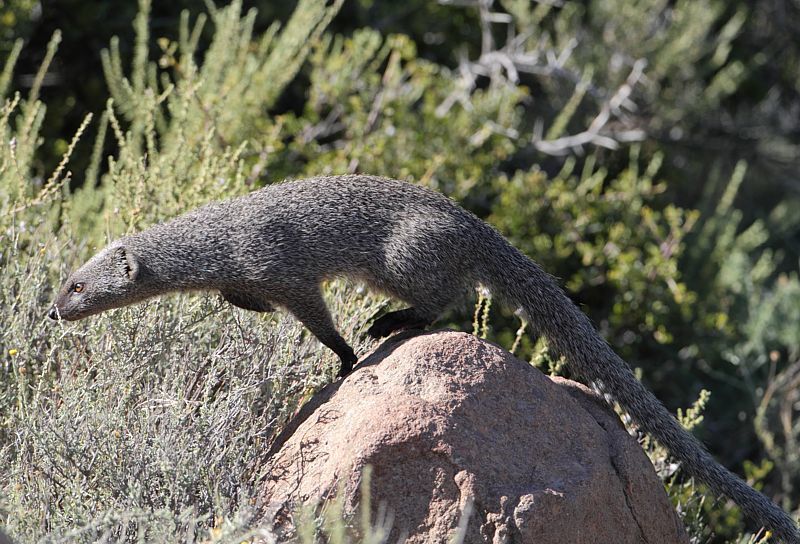
H18. Small Grey Mongoose (Herpestes pulverulentus)
HB: 29-41.5 cm 🔴 T: 20.5-34 cm 🔴 W: 0.49-1.25 kg
Distribution: South Africa, Lesotho and Southeastern Namibia
Habitat: Habitats with cover, farmland and in urban park land
Diet: Mainly small rodents, insects and occasionally kills neonate greysboks and juvenile Cape Porcupine. Also scavenges from carrion and dumps
Activity: Diurno-crepuscular
Social behaviour: Solitary, but adult males occasionally associate loosely in pairs
Home range: 0.55-0.92 km² (♂) 🔴 0.3 km² (1♀)
Threats: No significant threats
IUCN population trend: Stable
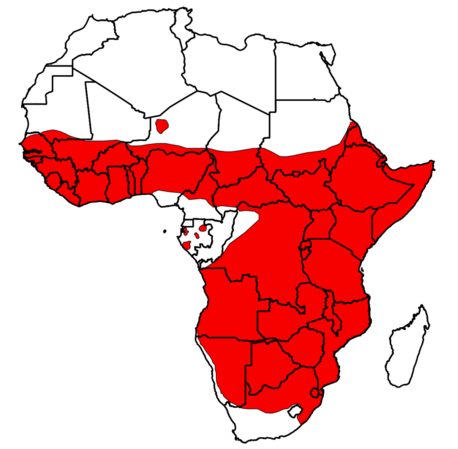
Research needs: xxx
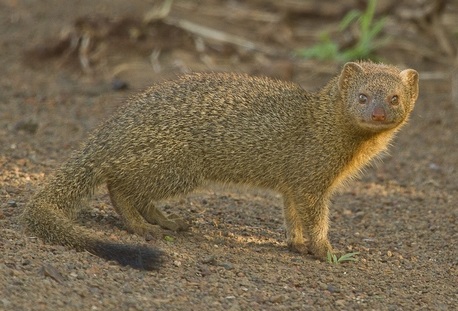
H19. Slender Mongoose (Herpestes sanguineus)
HB: 25.7-35 cm 🔴 T: 19.4-33 cm 🔴 W: 0.37-0.79 kg
Distribution: Ubiquitous in sub-Saharan Africa except the western Congo Basin, coastal Namibia, Eastern Cape and Western Cape and South Africa
Habitat: Occurs in most habitats (including anthropogenic ones) except true desert and rainforest
Diet: Insects, reptiles and small rodents are the main prey, as well as birds, amphibians, eggs, arachnids and wild fruits. Also scavenges from carrion, dumps and handouts
Activity: Diurnal
Social behaviour: Solitary but males may from groups (2-4 individuals)
Home range: 0.25-1 km²
Threats: No serious threats
IUCN population trend: Stable
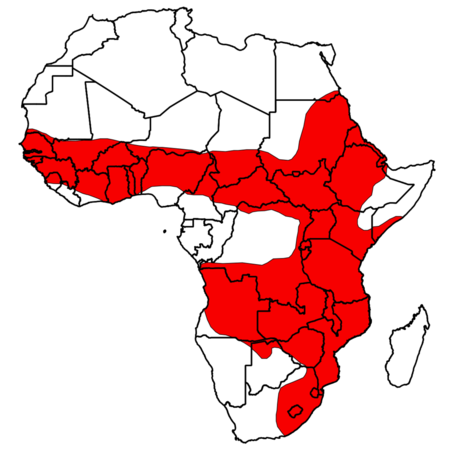
Research needs: xxx
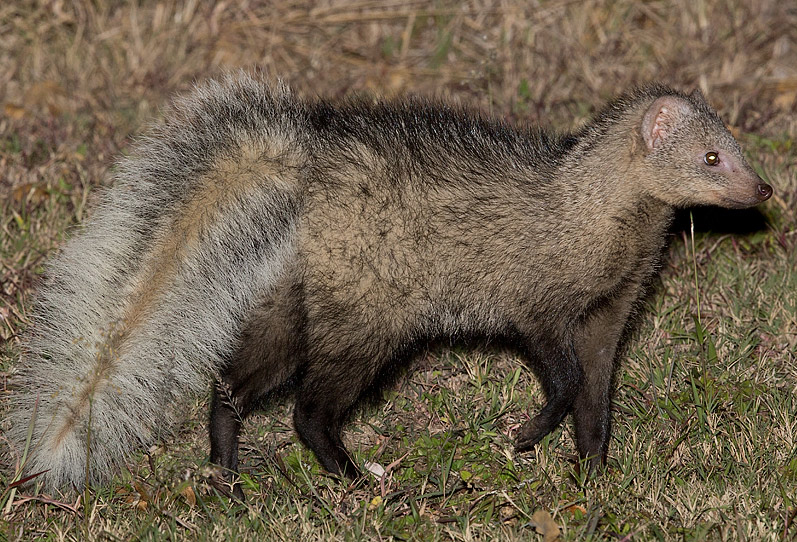
H20. White-tailed Mongoose (Ichneumia albicauda)
HB: 47-71 cm 🔴 T: 34.5-47 cm 🔴 W: 1.8-5.2 kg
Distribution: Sub-Saharan Africa except Northeastern Africa, the Congo Basin and Arid Southwestern Africa; occurs on the Southern Arabian Peninsula
Habitat: Moist and dry woodlands, savannah, scrubland, grassland and farmland
Diet: Mainly insectivorous, but small mammals, amphibians, birds, poultry, fruits and vegetable are also taken
Activity: Nocturnal
Social behaviour: Mostly solitary, but pairs males-females or small females with their offspring may be found
Home range: 0.4-4,3 km²
Threats: Killed on roads, during predator-control operations and by dogs in rural areas
IUCN population trend: Stable
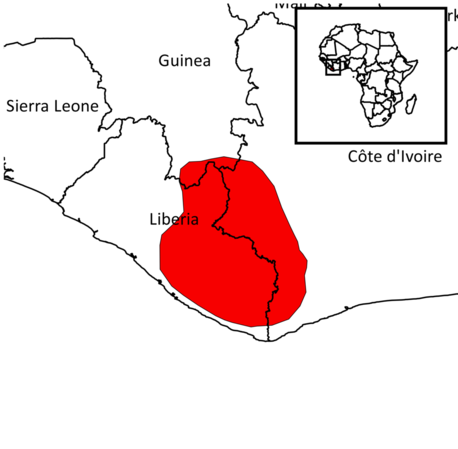
Research needs: xxx

© Name Surname
H21. Liberian Mongoose (Liberiictis kuhni)
HB: 42.3-46.8 cm 🔴 T: 19.7-20.5 cm 🔴 W: 2.3 kg (1♂)
Distribution: Côte d'Ivoire and Liberia
Habitat: Rainforest
Diet: Earthworms specialist, but arthropods, small vertebrates and fruits are also taken
Activity: Diurnal
Social behaviour: Highly social (4-6 individuals)
Home range: Nothing known
Threats: Habitat loss and bushmeat hunting are the serious threats
IUCN population trend: Decreasing
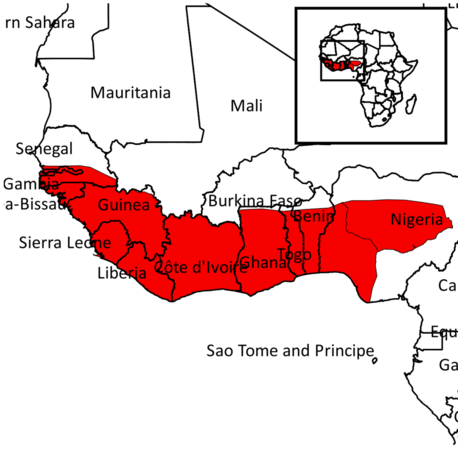
Research needs: xxx
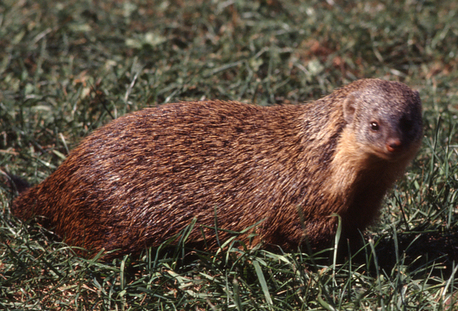
© H. van Rompaey*
H22. Gambian Mongoose (Mungos gambianus)
HB: 30-45 cm 🔴 T: 23-29 cm 🔴 W: 1-2.2 kg
Distribution: From Gambia and Southern Senegal to the Niger River, Nigeria
Habitat: Dry to semi-moist woodlands, open savannah, grassland and coastal scrub
Diet: Mainly arthropods, but small vertebrates such as rodents, snakes and lizards are also taken
Activity: Diurnal
Social behaviour: Highly social (5-15 individuals and up to 30-40)
Home range: Nothing known
Threats: Bushmeat hunting
IUCN population trend: Stable

Research needs: xxx

© C. & M. Stuart
H23. Banded Mongoose (Mungos mungos)
HB: 30-45 cm 🔴 T: 17.8-31 cm 🔴 W: 0.9-1,9 kg
Distribution: Sub-Saharan Africa; absent from forested Western and Central Africa and arid Southern Africa
Habitat: Woodland, savannah, grassland, farmland and cultivated areas
Diet: Mainly insectivorous, arthropods, but rodents, shrews, lizards, small snakes, amphibians, birds, fledglings, eggs and some fruits are also taken
Activity: Diurnal
Social behaviour: Highly social (12-20 individuals and up to 70-75)
Home range: 0.3-2 km²/group
Threats: No threats
IUCN population trend: Stable
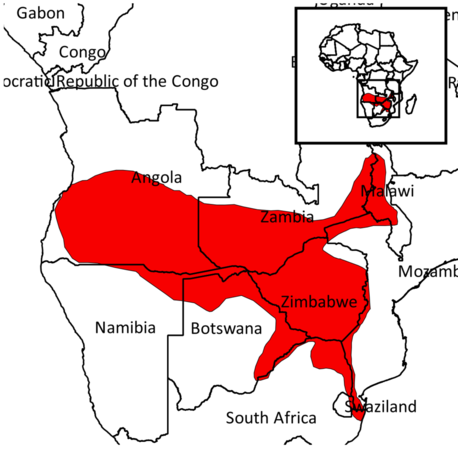
Research needs: xxx

© P. Apps
H24. Selou's Mongoose (Paracynictis selousi)
HB: 39-47 cm 🔴 T: 28-43.5 cm 🔴 W: 1.4-2.2 kg
Distribution: Southcentral Africa from Southern Angola to Malawi to Northern and Eastern Botswana, Northeastern South Africa and Southern Mozambique
Habitat: Dry and wet woodland savannah, scrub, grassland and cultivate areas with cover
Diet: Mainly Insects, but small rodents, herptiles and birds are also taken
Activity: Nocturnal
Social behaviour: Solitary
Home range: Nothing known
Threats: No threats
IUCN population trend: Unknown
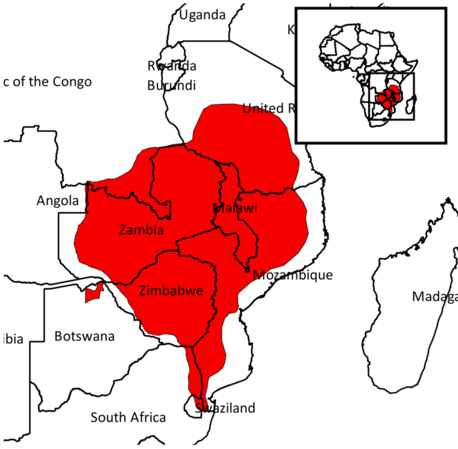
Research needs: Field studies to know their basic ecology, behaviour and conservation needs are paramount
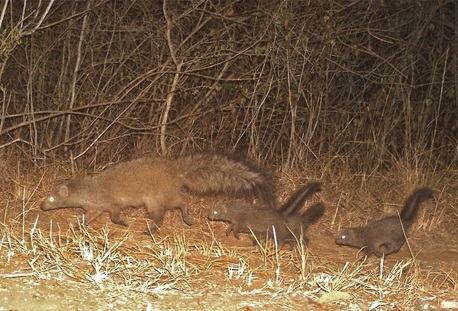
H25. Meller's Mongoose (Rhynchogale melleri)
HB: 44-50 cm 🔴 T: 28-41.2 cm 🔴 W: 1.8-2.8 kg
Distribution: Southwest Africa
Habitat: Savannah, open woodland and grasslands
Diet: Mainly insectivorous, termites, but frogs and reptiles also taken
Activity: Nocturnal
Social behaviour: Solitary ?
Home range: Nothing known
Threats: Human persecution
IUCN population trend: Unknown
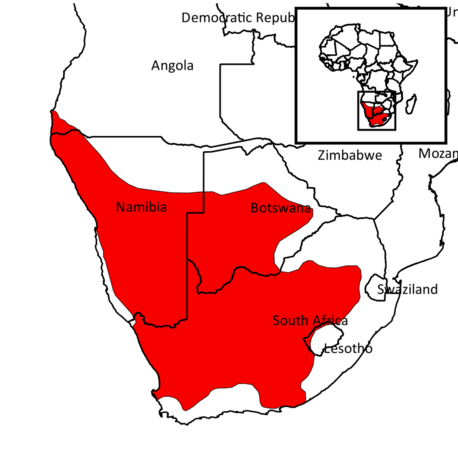
Research needs: This species has been extensively studied
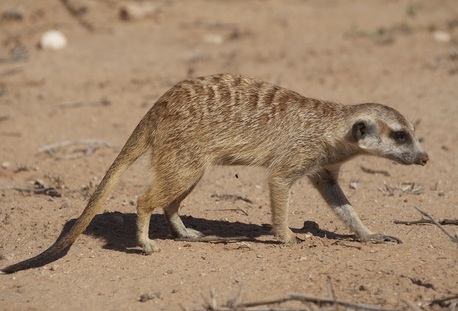
H26. Meerkat (Suricata suricatta)
HB: 24.5-29 cm 🔴 T: 19-24 cm 🔴 W: 620-969 g
Distribution: East of South Africa
Habitat: Open semi-arid areas, scrub and grasslands
Diet: Insectivorous, manliy insects, but small reptiles also taken
Activity: Diurnal
Social behaviour: Social groups (up to 20)
Home range: 2-10 km²
Threats: Human
IUCN population trend: Stable
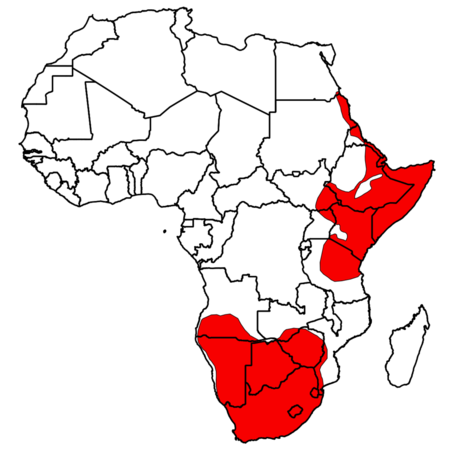
Research needs: TBD

Y1. Aardwolf (Proteles cristatus)
HB: 55-80 cm 🔴 T: 20-40 cm 🔴 W: 8-14 kg
Distribution: North East, Central East and Southern Africa
Habitat: Open plain grasslands and savannahs with different tree densities
Diet: Almost exclusively on termites
Activity: Nocturnal, some diurnal activity in winter
Social behaviour: Pair + yearlings
Home range: 1.5-3.8 km²
Threats: Poison, human persecution, vehicles
IUCN population trend: Stable

Research needs: TBD

M1. African Clawless Otter (Aonyx capensis)
HB: 73-88 cm 🔴 T: 46.5-51.5 cm 🔴 W: 10-21 kg
Distribution: Central and Southern Africa
Habitat: Mostly freshwater riverine forests, rainforests and swamp forests and forest rivers in open coastal plain water areas
Diet: Primarily crab-eaters, but frogs, fish and insects also taken
Activity: Nocturnal, some diurnal activity in remote areas
Social behaviour: Mostly solitary, but family groups may be found
Home range: 14-20 km²
Threats: Habitat destruction and water pollution
IUCN conservation status: Near Threatened (NT)
IUCN population trend: Decreasing
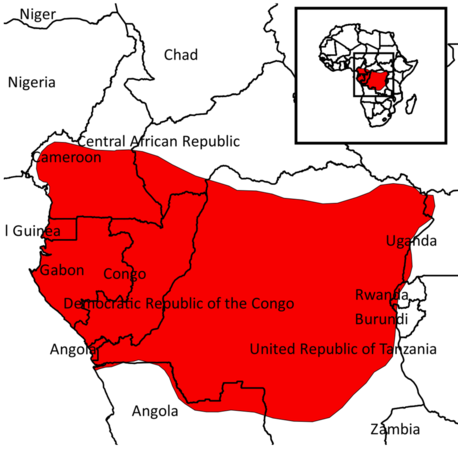
Research needs: Field studies to know their basic ecology, behaviour and conservation needs are paramount

© Name Surname
M2. Congo Clawless Otter (Aonyx congicus)
HB: 79-97 cm 🔴 T: 41-56 cm 🔴 W: 14-25 kg
Distribution: East of Central Africa
Habitat: Undisturbed rainforests, rivers, wetlands and swamps
Diet: Fish, crabs, earthworms, frogs and aquatic insects
Activity: Diurnal and crespuscular (in remote areas)
Social behaviour: Mostly solitary, but family groups may be found
Home range: Nothing known
Threats: Forest fragmentation, human persecution (bushmeat)
IUCN conservation status: Near Threatened (NT)
IUCN population trend: Decreasing

Research needs: TBD

M3. Spotted-necked Otter (Hydrictis maculicollis)
HB: 57-76 cm 🔴 T: 38.5-44 cm 🔴 W: 3.8-6 kg
Distribution: Central and Southern East Africa
Habitat: Freshwater rivers, lakes and swamps
Diet: Fish, crabs and frogs, but birds and insects are also taken
Activity: Diurnal
Social behaviour: Family groups
Home range: 5.8-16.2 km²
Threats: Habitat destruction and water pollution
IUCN conservation status: Near Threatened (NT)
IUCN population trend: Decreasing
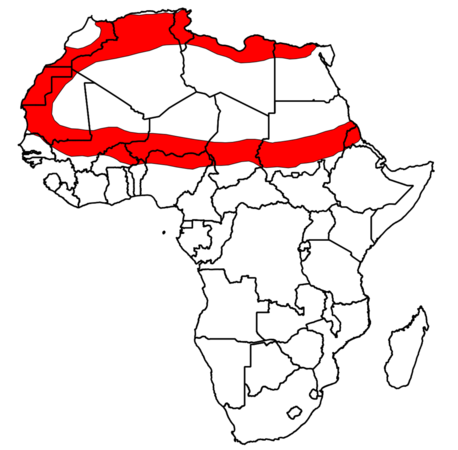
Research needs: Field studies to know their basic ecology, behaviour and conservation needs are paramount
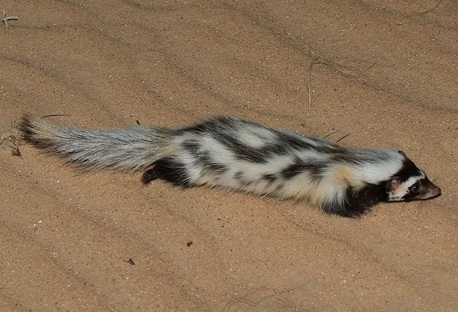
© A. Sliwa
M4. Libyan Striped Weasel (Ictonyx libycus)
HB: 20.7-26 cm 🔴 T: 11.4-18 cm 🔴 W: 200-600 g
Distribution: Nort Africa, except Sahara desert
Habitat: Sub-desert areas, rocky areas, steppes and areas of sparse brush
Diet: rodents, small birds, eggs, lizards and insects
Activity: Nocturnal
Social behaviour: Solitary
Home range: Nothing known
Threats: Nothing known
IUCN conservation status: Least Concern (LC)
IUCN population trend: Unknown
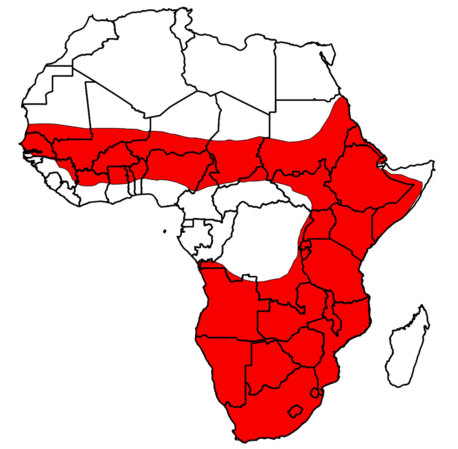
Research needs: Field studies to know their basic ecology, behaviour and conservation needs are paramount

Unknown source
M5. Zorilla (Ictonyx striatus)
HB: 28-38 cm 🔴 T: 16.5-28 cm 🔴 W: 0.4-1.2 kg
Distribution: Across Africa, except North and East Central Africa
Habitat: Great variety, mountains, sand plains, forest, swamps, riverine woodlands and grasslands
Diet: Mainly small rodents and insects, but birds, eggs and reptiles are also taken
Activity: Nocturnal
Social behaviour: Solitary + pairs often seen
Home range: Nothing known
Threats: Vehicles
IUCN conservation status: Least Concern (LC)
IUCN population trend: Stable
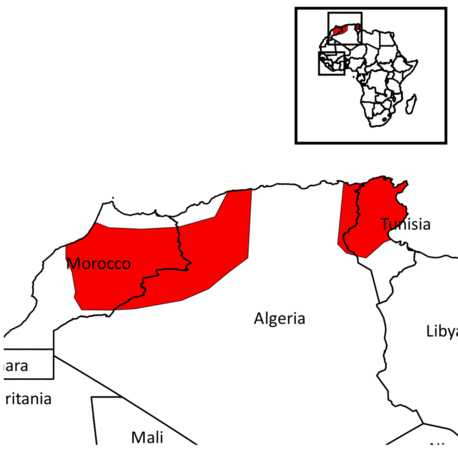
Research needs: Very little is known about this species in North Africa
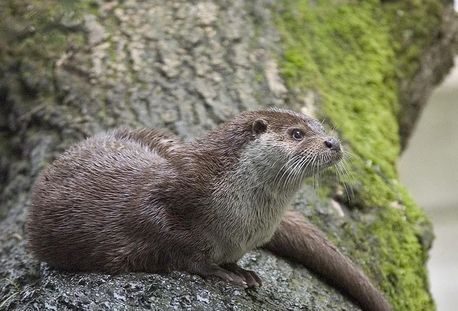
Unknown source
M6. Eurasian Otter (Lutra lutra)
HB: 50-82 cm 🔴 T: 37.5-50 cm 🔴 W: 5-14 kg
Distribution: Morocco, North Algeria and Tunisia
Habitat: Lakes, rivers, streams, swamps, coastal and estuarine wetlands
Diet: Mainly fish, frogs, crabs but birds and small mammals are also taken
Activity: Mainly norcturnal and crepuscular
Social behaviour: Males are solitary but females live in groups
Home range: 7-15 km (linear home range)
Threats: Water pollution, human persecution (fur), vehicles
IUCN conservation status: Near Threatened (NT)
IUCN population trend: Decreasing
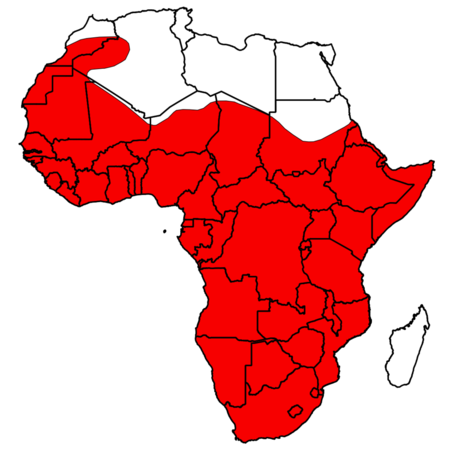
Research needs: Population densities and human-wildlife conflicts

© E. Do Linh San
M7. Honey Badger (Mellivora capensis)
HB: 73-96 cm 🔴 T: 14.3-23 cm 🔴 W: 6.2-13.6 kg
Distribution: North west, Central and Southern Africa
Habitat: Very diverse: from deep, subtropical and evergreen forests; to open and riparian woodlands, afro-alpine steppes, savannah, etc.
Diet: Omnivorous
Activity: Nocturnal but diurnal activity has been recorded
Social behaviour: Solitary, but pairs are often seen
Home range: 126-541 km²
Threats: Human persecution
IUCN conservation status: Least Concern (LC)
IUCN population trend: Decreasing
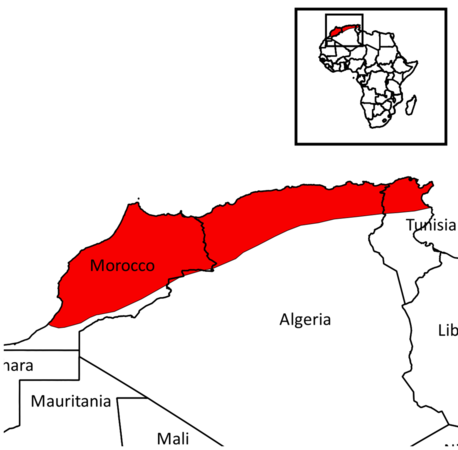
Research needs: Field studies to know their basic ecology, behaviour and conservation needs are paramount
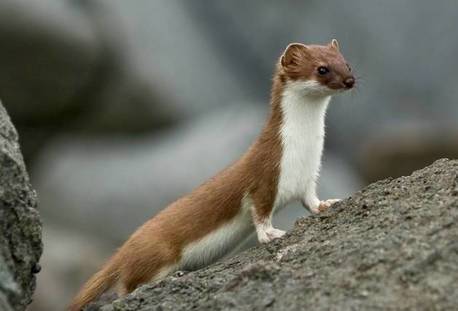
Unknown source
M8. Least Weasel (Mustela nivalis)
HB: 11.4-26 cm 🔴 T: 7-9 cm 🔴 W: 0.025-0.25 kg
Distribution: Morocco, North Algeria and Tunisia
Habitat: Agricultural fields, grasslands, forests, riparian woodlands, hedgerows and coastal dunes
Diet: Mainly small rodents, birds, reptiles, frogs and insects are also taken
Activity: Both Nocturnal and diurnal (mixed)
Social behaviour: Solitary
Home range: 0.6-26 ha (♂) 🔴 0.2-7 ha (♀)
Threats: Poison, human persecution, vehicles
IUCN conservation status: Least Concern (LC)
IUCN population trend: Stable
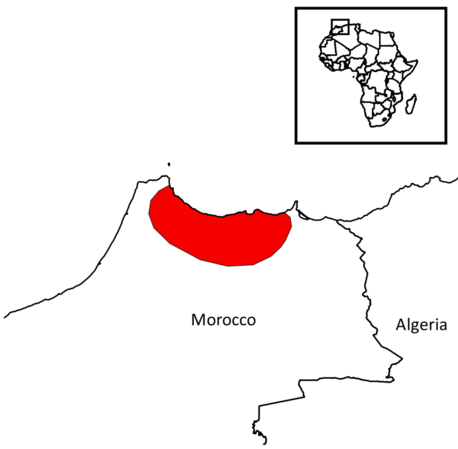
Research needs: Almost nothing is known about this species in Morocco
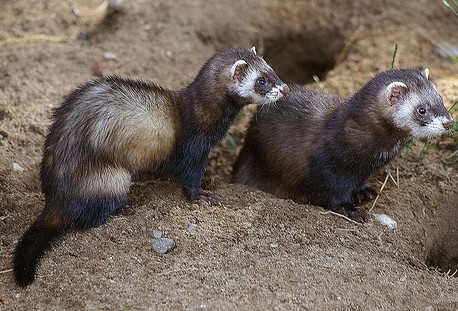
Unknown source*
M9. Western Polecat (Mustela putorius)
HB: 20.5-46 cm 🔴 T: 7-19 cm 🔴 W: 0.4-1.7 kg
Distribution: Morocco
Habitat: Forests, meadows, abandoned fields and agricultural areas often near water sources
Diet: Amphibians, small mammals, fish, birds and invertebrates
Activity: Nocturnal, but crespucular and diurnal activity can occur
Social behaviour: Solitary
Home range: 0.42-4.28 km²
Threats: Human persecution; hunted for fur; vehicles
IUCN conservation status: Least Concern (LC)
IUCN population trend: Decreasing
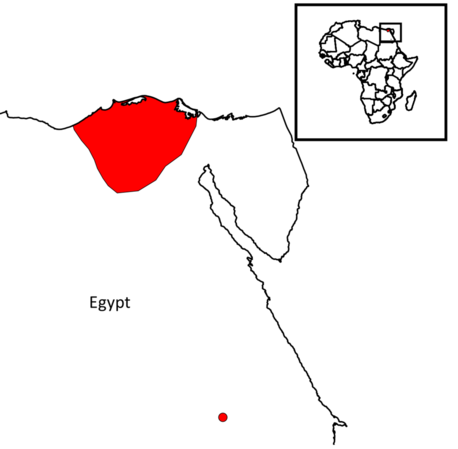
Research needs: Almost nothing is known about this species' basic behaviour and ecology

© Name Surname
M10. Egyptian Weasel (Mustela subpalmata)
HB: 27-30 cm 🔴 T: 10.7-12.9 cm 🔴 W: 45-130 g
Distribution: Egypt
Habitat: Fields near water channels, found near towns and villages
Diet: Small mammals and insects
Activity: Unknown
Social behaviour: Unknown
Home range: Unknown
Threats: Unknown
IUCN conservation status: Least Concern (LC)
IUCN population trend: Increasing
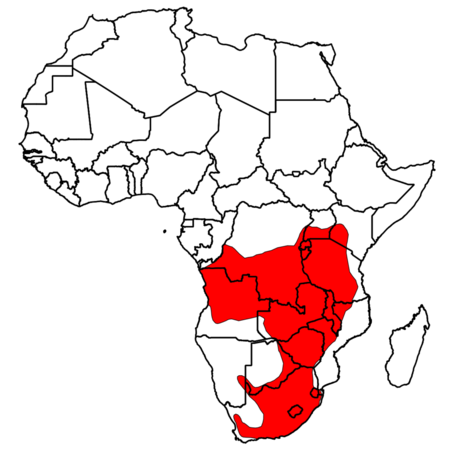
Research needs: Field studies to know their basic ecology, behaviour and conservation needs are paramount

© Name Surname
M11. African Striped Weasel (Poecilogale albinucha)
HB: 24-33 cm 🔴 T: 13.8-20 cm 🔴 W: 210-380 g
Distribution: Central and Southern Africa
Habitat: Grasslands, savannahs, forests, pine plantations and agricultural land
Diet: Small rodents, reptiles, birds and eggs are also taken
Activity: Nocturnal, but some diurnal activity may take place
Social behaviour: Solitary, but pairs or small groups are found
Home range: Unknown
Threats: Unknown
IUCN conservation status: Least Concern (LC)
IUCN population trend: Unknown
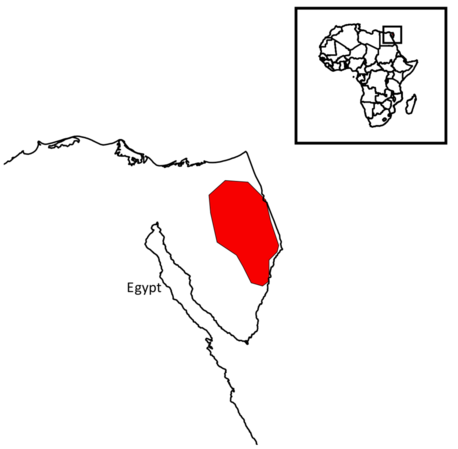
Research needs: Field studies to know their basic ecology, behaviour and conservation needs are paramount

Unknown source*
M12. Marbled Polecat (Vormela peregusna)
HB: 28.8-47.7 cm 🔴 T: 15.5-17.8 cm 🔴 W: 295-750 g
Distribution: East Egypt
Habitat: Open desert, semi-arid rocky and sparsely vegetated areas
Diet: Omnivourous, mainly small mammals, birds, reptiles, eggs, insects and fruits also taken
Activity: Nocturnal and crepuscular, but diurnal activity also recorded
Social behaviour: Solitary?
Home range: 0.5-0.6 km²
Threats: Loss of natural steppes and desert habitats, Human persecution (bushmeat), vehicles
IUCN conservation status: Vulnerable (VU)
IUCN population trend: Decreasing

Research needs: Field studies to know their basic ecology, behaviour and conservation needs are paramount

© David Mills*
N1. African Palm Civet (Nandinia binotata)
HB: 37-62.5 cm 🔴 T: 34-76.2 cm 🔴 W: 1.2-3 kg
Distribution: Western and Central Africa
Habitat: Montane tropical forests, riparian deciduous forests and savannah woodlans
Diet: Omnivora, mainly fruits but small mammals, birds and insects were also recorded
Activity: Nocturnal
Social behaviour: Solitary
Home range: 34-153 ha (♂) 🔴 29-70 ha (♀)
Threats: Human persecution (bushmeat), habitat fragmentation
IUCN conservation status: Least Concern (LC)
IUCN population trend: Unknown

Research needs: TBD

Unknown source
V1. African Civet (Civettictis civetta)
HB: 67-84 cm 🔴 T: 34-46.9 cm 🔴 W: 7-20 kg
Distribution: Western, Eastern and Southern East Africa
Habitat: Forest and open habitats with understory, riverine habitats in drier regions
Diet: Omnivorous: invertebrates, fruits, small vertebrates, eggs and grass
Activity: Mainly nocturnal, but crespuscular activity has also been recorded
Social behaviour: Solitary; pairs + yearlings also recorded
Home range: Unknown
Threats: Human persecution (bushmeat)
IUCN conservation status: Least Concern (LC)
IUCN population trend: Unknown
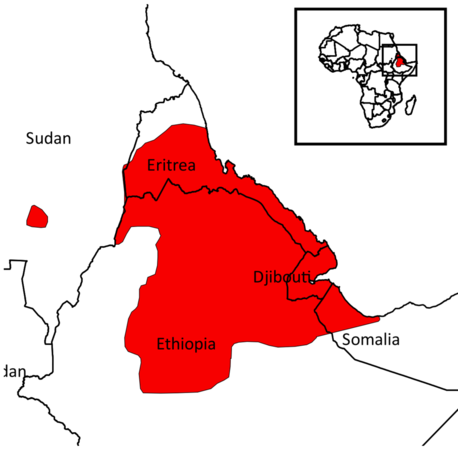
Research needs: Field studies to know their basic ecology, behaviour and conservation needs are paramount

© Name Surname
V2. Ethiopian Genet (Genetta abyssinica)
HB: 40.8-43 cm 🔴 T: 38-40.3 cm 🔴 W: 1.3-2 kg
Distribution: Djibouti, Eritrea, Ethiopia, Somalia and Sudan
Habitat: Montane dry forests, Afro-alpine grassland, steppes and sub-desert areas
Diet: Mainly small mammals, but insects, birds and fruits also taken
Activity: Nocturnal but some diurnal activity was recorded
Social behaviour: Solitary ?
Home range: Nothing known
Threats: Habitat fragmentation
IUCN conservation status: Data Deficient (DD)
IUCN population trend: Unknown
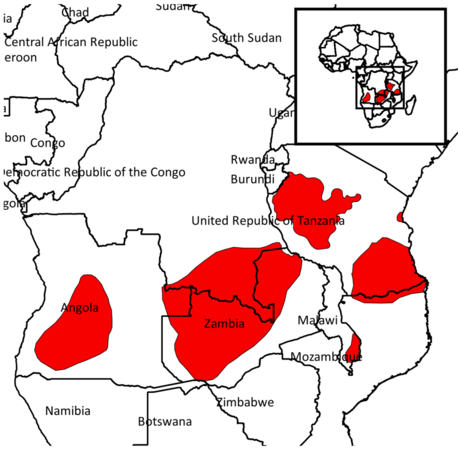
Research needs: Field studies to know their basic ecology, behaviour and conservation needs are paramount

© Name Surname
V3. Miombo Genet (Genetta angolensis)
HB: 44-47.8 cm 🔴 T: 38-43 cm 🔴 W: 1.3-2 kg
Distribution: Sparsed distribution across Central Africa
Habitat: Open miombo woodlands, savannah
Diet: Omnivorous, small mammals, insects, fruits and grass
Activity: Nocturnal
Social behaviour: Nothing known
Home range: Nothing known
Threats: Nothing known
IUCN conservation status: Least Concern (LC)
IUCN population trend: Unknown
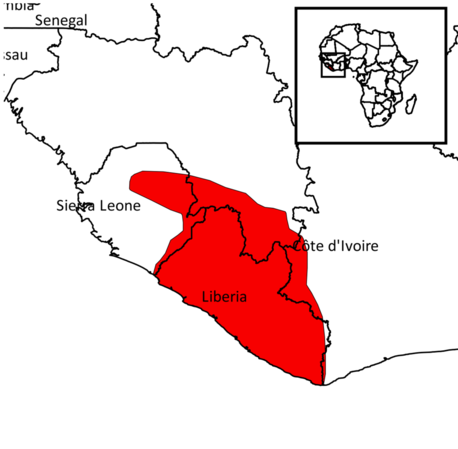
Research needs: Field studies to know their basic ecology, behaviour and conservation needs are paramount

© Name Surname
V4. Bourlon's Genet (Genetta bourloni)
HB: 49.5 cm 🔴 T: 41 cm 🔴 W: 1.5-2.0 kg
Distribution: Guinea, Ivory Coast, Liberia and Sierra Leone
Habitat: Rainforest
Diet: Nothing known
Activity: Nothing known
Social behaviour: Nothing known
Home range: Nothing known
Threats: Habiat (forest) fragmentation, human persectuion (bushmeat)
IUCN conservation status: Vulnerable (VU)
IUCN population trend: Decreasing
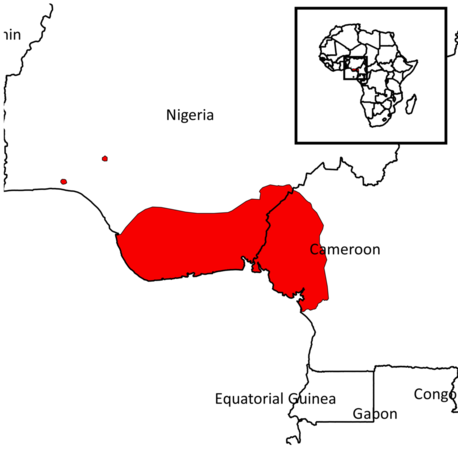
Research needs: Field studies to know their basic ecology, behaviour and conservation needs are paramount

© Name Surname
V5. Crested Genet (Genetta cristata)
HB: 49.5-62.2 cm 🔴 T: 43.1-43.2 cm 🔴 W: 2.5 kg
Distribution: Cameroon, Nigeria and possibly Gabon and PR Congo
Habitat: Deciduous forest with understory cover and montane forest
Diet: Omnivorous, Small mammals, insects, birds, reptiles and plant material also recorded
Activity: Crepuscular? (from captivity animals)
Social behaviour: Nothing known
Home range: Nothing known
Threats: Forest fragmentation, hunting (bushmeat)
IUCN conservation status: Vulnerable (VU)
IUCN population trend: Decreasing
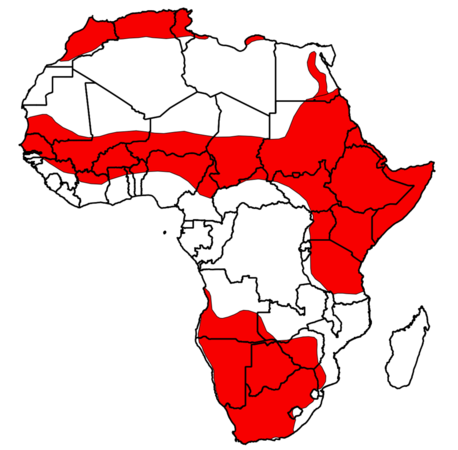
Research needs: Field studies to know their basic ecology, behaviour and conservation needs are paramount

© Name Surname
V6. Small-spotted Genet (Genetta genetta)
HB: 46.5-52 cm 🔴 T: 40-51.6 cm 🔴 W: 1.4-2.6 kg
Distribution: All Africa except Sahara desert and Western Africa
Habitat: Diverse range, but mainly associated with tree and bush cover, present also in rocky outcrops
Diet: Omnivorous, mainly small mammals, birds, insects, reptiles, eggs, fruits and grass also taken
Activity: Nocturnal
Social behaviour: Solitary + pairs occasionally observed
Home range: 0.25-14.7 km²
Threats: Human persecution (bushmeat), vehicles
IUCN conservation status: Least Concern (LC)
IUCN population trend: Stable
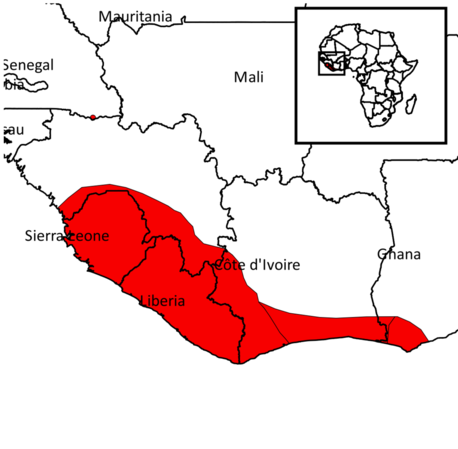
Research needs: Field studies to know their basic ecology, behaviour and conservation needs are paramount

© Name Surname
V7. Johnston's Genet (Genetta johnstoni)
HB: 47-51.4 cm 🔴 T: 46.2-49.5 cm 🔴 W: 2.2-2.6 kg
Distribution: Ghana, Guinea, Ivory Coast, Liberia and Sierra Leone
Habitat: Rainforest, wetlands like swamps and riverine forests
Diet: Nothing known
Activity: Nocturnal
Social behaviour: Solitary + pairs occasionally seen
Home range: Nonthing known
Threats: Forest fragmentation, human persecution (bushmeat)
IUCN conservation status: Near Threatened (NT)
IUCN population trend: Decreasing

Research needs: TBD

© Name Surname
V8. Rusty-spotted Genet (Genetta maculata)
HB: 41.1-52.1 cm 🔴 T: 39.5-54 cm 🔴 W: 1.3-3.2 kg
Distribution: All Africa except Nothern and Western Southern Africa
Habitat: Rainforest, woodland savannah, montane forest, wet habitats such as riparian and swamps, also occur in farmlands
Diet: Omnivorous, mainly small mammals, but fruits and seed are also taken
Activity: Nocturnal + some crepuscular activity recorded
Social behaviour: Solitary
Home range: 2.8-5.9 km²
Threats: Human persecution (bushmeat), vehicles
IUCN conservation status: Least Concern (LC)
IUCN population trend: Unknown
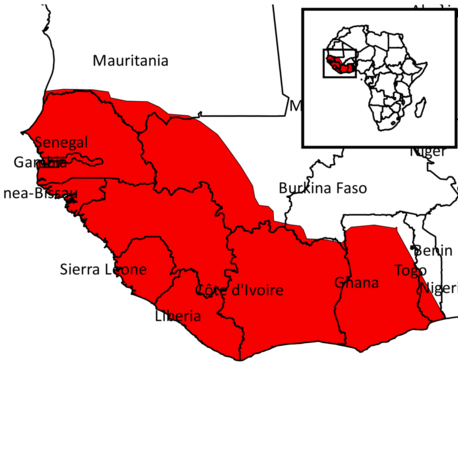
Research needs: Field studies to know their basic ecology, behaviour and conservation needs are paramount

© Name Surname
V9. Pardine Genet (Genetta pardina)
HB: 41-55.3 cm 🔴 T: 39-53 cm 🔴 W: up to 3.1 kg
Distribution: Western Africa
Habitat: Rainforests, riparian forests and moist woodlands
Diet: Omnivorous, mainly small mammals, insects and fruits
Activity: Nocturnal
Social behaviour: Solitary
Home range: Nothing known
Threats: Human persecution (bushmeat)
IUCN conservation status: Least Concern (LC)
IUCN population trend: Unknown
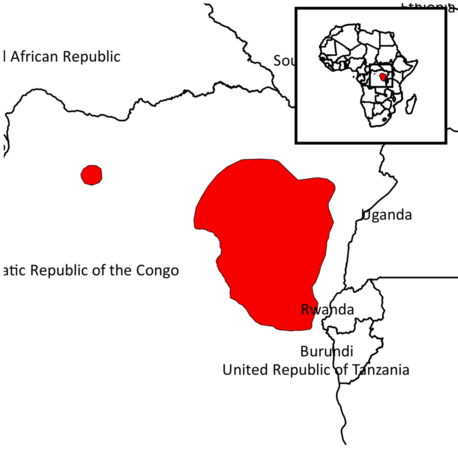
Research needs: Field studies to know their basic ecology, behaviour and conservation needs are paramount

© Name Surname
V10. Aquatic Genet (Genetta piscivora)
HB: 44.5-49.5 cm 🔴 T: 34-41.5 cm 🔴 W: 1.5 kg
Distribution: DR Congo
Habitat: Rainforest
Diet: Mainly fish
Activity: Nocturnal and Crepuscular
Social behaviour: Solitary
Home range: Nothing known
Threats: Human persecution (bushmeat)
IUCN conservation status: Near Threatened (NT)
IUCN population trend: Decreasing
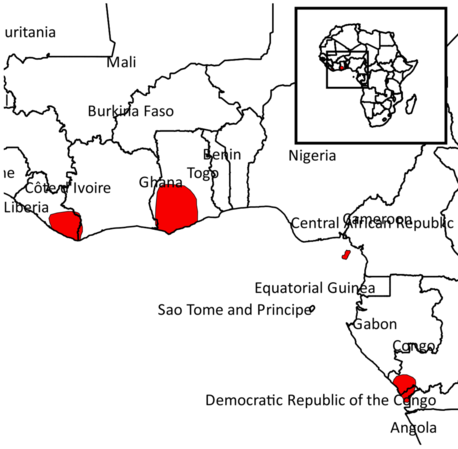
Research needs: Field studies to know their basic ecology, behaviour and conservation needs are paramount

© Name Surname
V11. King Genet (Genetta poensis)
HB: 60.2 cm 🔴 T: 41.5 cm 🔴 W: 2-2.5 kg
Distribution: Liberia, Ivory Coast, Ghana, Equatorial Guinea and PR Congo
Habitat: Rainforest
Diet: Nothing known
Activity: Nothing known
Social behaviour: Nothing known
Home range: Nothing known
Threats: Human persecution (bushmeat)
IUCN conservation status: Data Deficient (DD)
IUCN population trend: Unknown
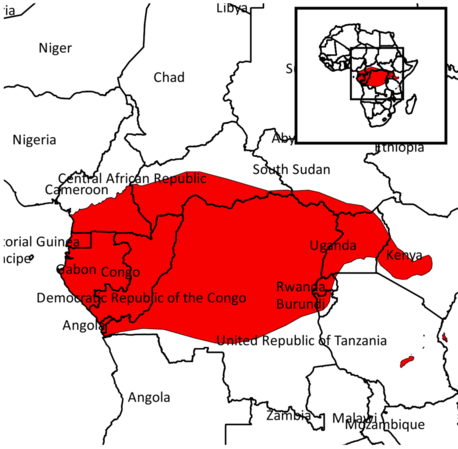
Research needs: Field studies to know their basic ecology, behaviour and conservation needs are paramount

© Name Surname
V12. Servaline Genet (Genetta servalina)
HB: 44.5-51 cm 🔴 T: 36-48.5 cm 🔴 W: 2.3 kg
Distribution: Central Africa
Habitat: Woodland savannah, savannah-forest mosaic and gallery forest
Diet: Omnivorous, mainly small mammals, but insects, reptiles, amphibians, birds and fruit are also taken
Activity: Nocturnal
Social behaviour: Solitary
Home range: Nothing known
Threats: Human persecution (bushmeat)
IUCN conservation status: Least Concern (LC)
IUCN population trend: Unknown
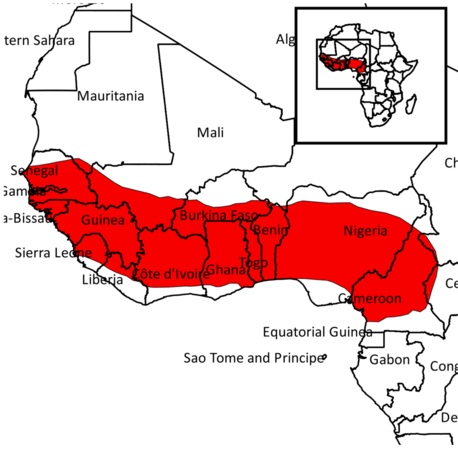
Research needs: Field studies to know their basic ecology, behaviour and conservation needs are paramount

© Name Surname
V13. Hausa Genet (Genetta thierryi)
HB: 44.3-45 cm 🔴 T: 40-43 cm 🔴 W: 1.3-1.5 kg
Distribution: Western Africa
Habitat: Dry savannahs, open woodlands, also found in rainforests
Diet: Nothing known
Activity: Nocturnal
Social behaviour: Nothing known
Home range: Nothing known
Threats: Human persecution (bushmeat)
IUCN conservation status: Least Concern (LC)
IUCN population trend: Unknown
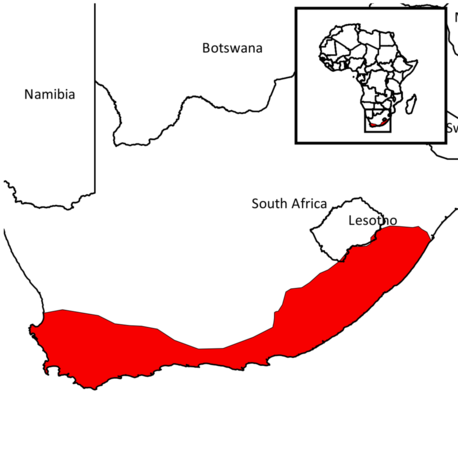
Research needs: TBD

© Name Surname
V14. Cape Genet (Genetta tigrina)
HB: 42.7-58 cm 🔴 T: 38-45.9 cm 🔴 W: 1.4-2.1 kg
Distribution: South Africa and Lesotho
Habitat: Forests, lowland and montane fymbos, riparian zones and scrub and open grasslands
Diet: Omnivorous, mainly small mammals, but birds, insects, crabs, earthworms and plants are also taken
Activity: Nocturnal
Social behaviour: Solitary + yearlings
Home range: Nothing known
Threats: Human persecution, vehicles
IUCN conservation status: Least Concern (LC)
IUCN population trend: Stable
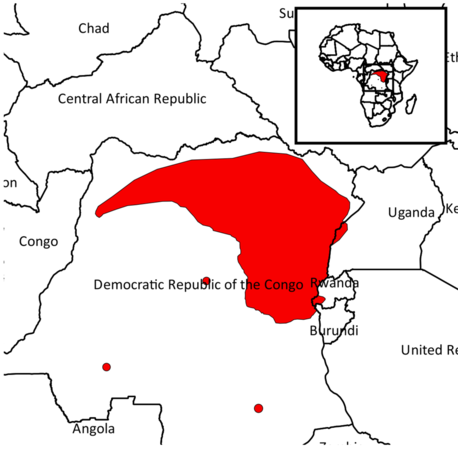
Research needs: Field studies to know their basic ecology, behaviour and conservation needs are paramount

© Name Surname
V15. Giant Genet (Genetta victoriae)
HB: 55-60 cm 🔴 T: 41.3-49 cm 🔴 W: 2.5-3.5 kg
Distribution: DR Congo and West Uganda
Habitat: Rainforest
Diet: Nothing known
Activity: Nocturnal
Social behaviour: Solitary
Home range: Nothing known
Threats: Human persecution (bushmeat)
IUCN conservation status: Least Concern (LC)
IUCN population trend: Unknown

Research needs: Field studies to know their basic ecology, behaviour and conservation needs are paramount

© Name Surname
V16. West African Linsang (Poiana leightoni)
HB: 30-38 cm 🔴 T: 35-40 cm 🔴 W: 500-700 g
Distribution: Ivory Coast and Liberia
Habitat: Rainforest
Diet: Omnivorous, insects, birds and plants
Activity: Nothing known
Social behaviour: Nothing known
Home range: Nothing known
Threats: Forest fragmentaion
IUCN conservation status: Vulnerable (VU)
IUCN population trend: Decreasing

Research needs: Field studies to know their basic ecology, behaviour and conservation needs are paramount

© Name Surname

